Screened-in porches offer a perfect blend of indoor comfort and outdoor ambiance, and adding a fireplace elevates this space into a cozy retreat usable year-round. Whether you prefer the crackling warmth of a wood-burning hearth or the convenience of a gas insert, a well-designed fireplace becomes the focal point, crafting both visual interest and functional heating. Incorporating durable materials like stone or brick ties the fireplace seamlessly into the porch’s architecture while natural wood accents bring rustic charm. Modern designs favor minimalist surrounds and sleek electric units, offering low-maintenance elegance. Safety features, proper ventilation, and weather-resistant furnishings ensure your screened-in porch remains inviting through every season.
1. Benefits of Adding a Fireplace to a Screened-in Porch
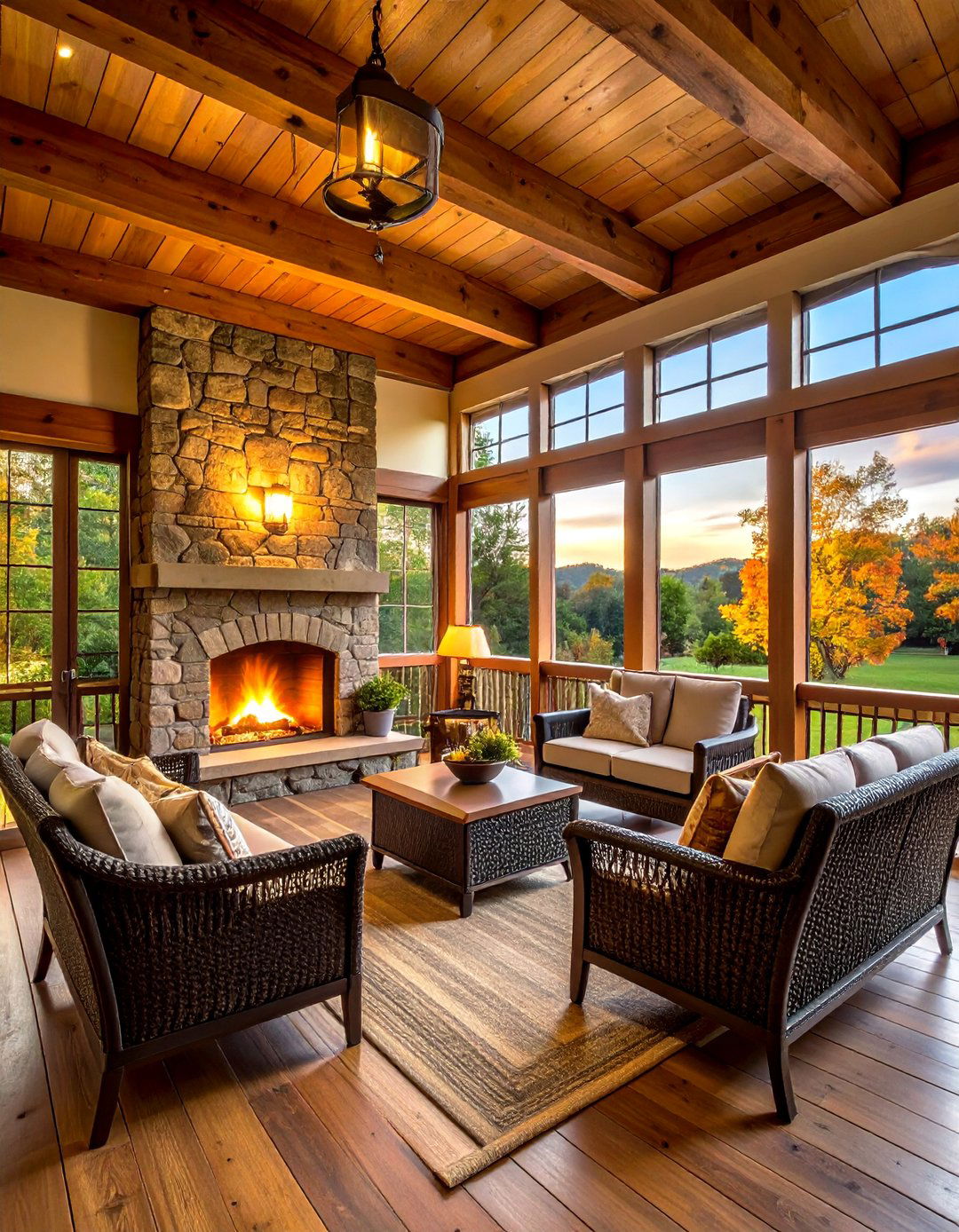
A fireplace transforms a seasonal porch into a versatile living area, extending its usability into cooler months for fall gatherings or winter relaxation. The warmth it provides allows you to enjoy fresh air even when temperatures drop, effectively expanding your home’s footprint without costly additions. A central hearth also serves as a natural gathering spot, encouraging conversation and intimate moments around the fire. Beyond heat, fireplaces add architectural interest and can significantly boost property value by enhancing outdoor living appeal. Strategically positioned, a fireplace anchors the design scheme and complements both seating and dining arrangements.
2. Choosing the Right Fireplace Type: Wood, Gas, or Electric
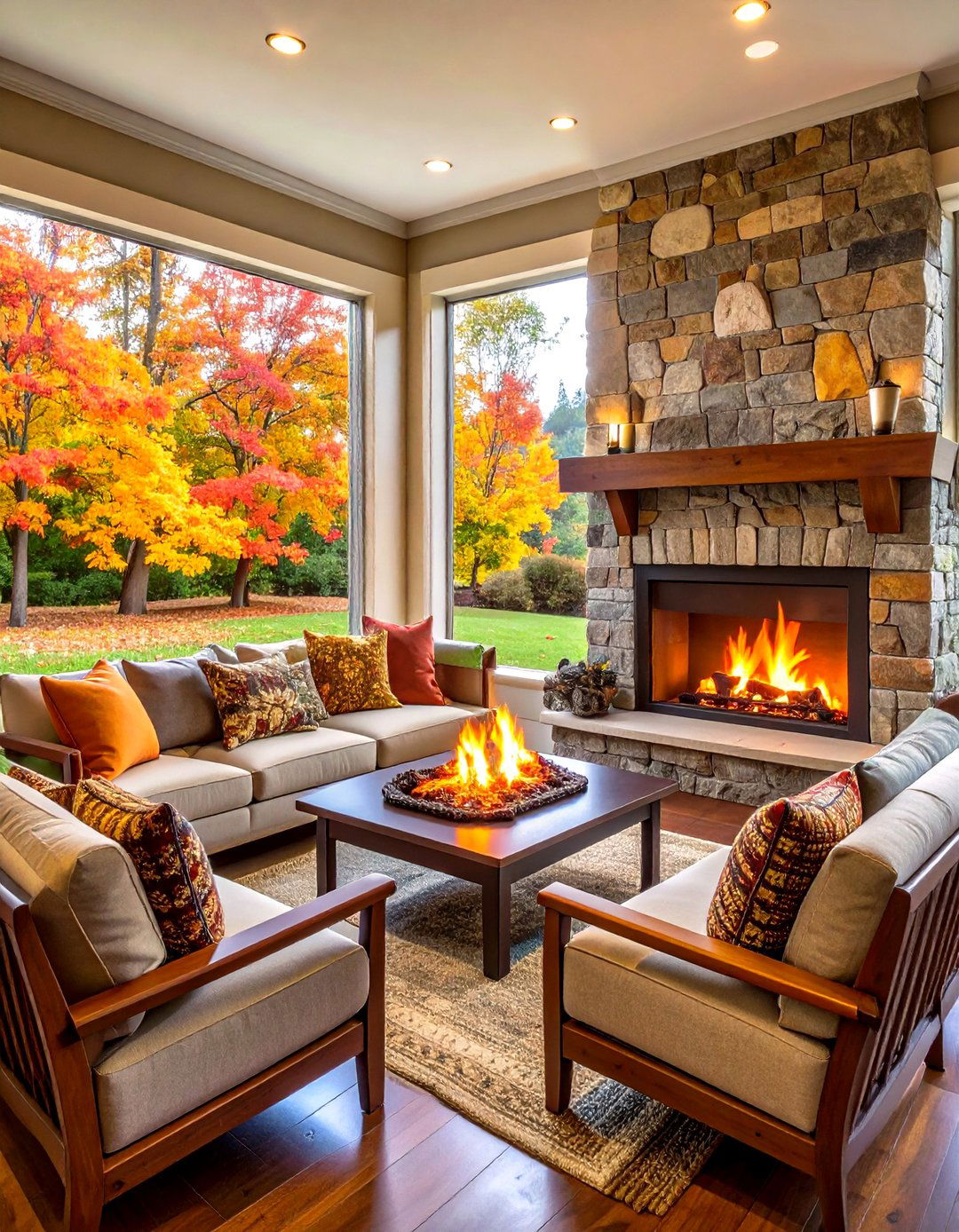
Wood-burning fireplaces evoke traditional charm with authentic crackle and aroma, but require chimneys, clearances, and frequent maintenance. Gas inserts offer instant warmth at the flip of a switch, minimal upkeep, and flexible venting options suited for screened porches lacking full masonry chimneys. Electric fireplaces deliver easy installation, precise temperature control, and safety, though they lack the ambiance of real flames. Consider local building codes, fuel availability, and installation budget when selecting the ideal type. Each option balances aesthetics, functionality, and cost in unique ways.
3. Designing for Climate: Extending the Outdoor Season
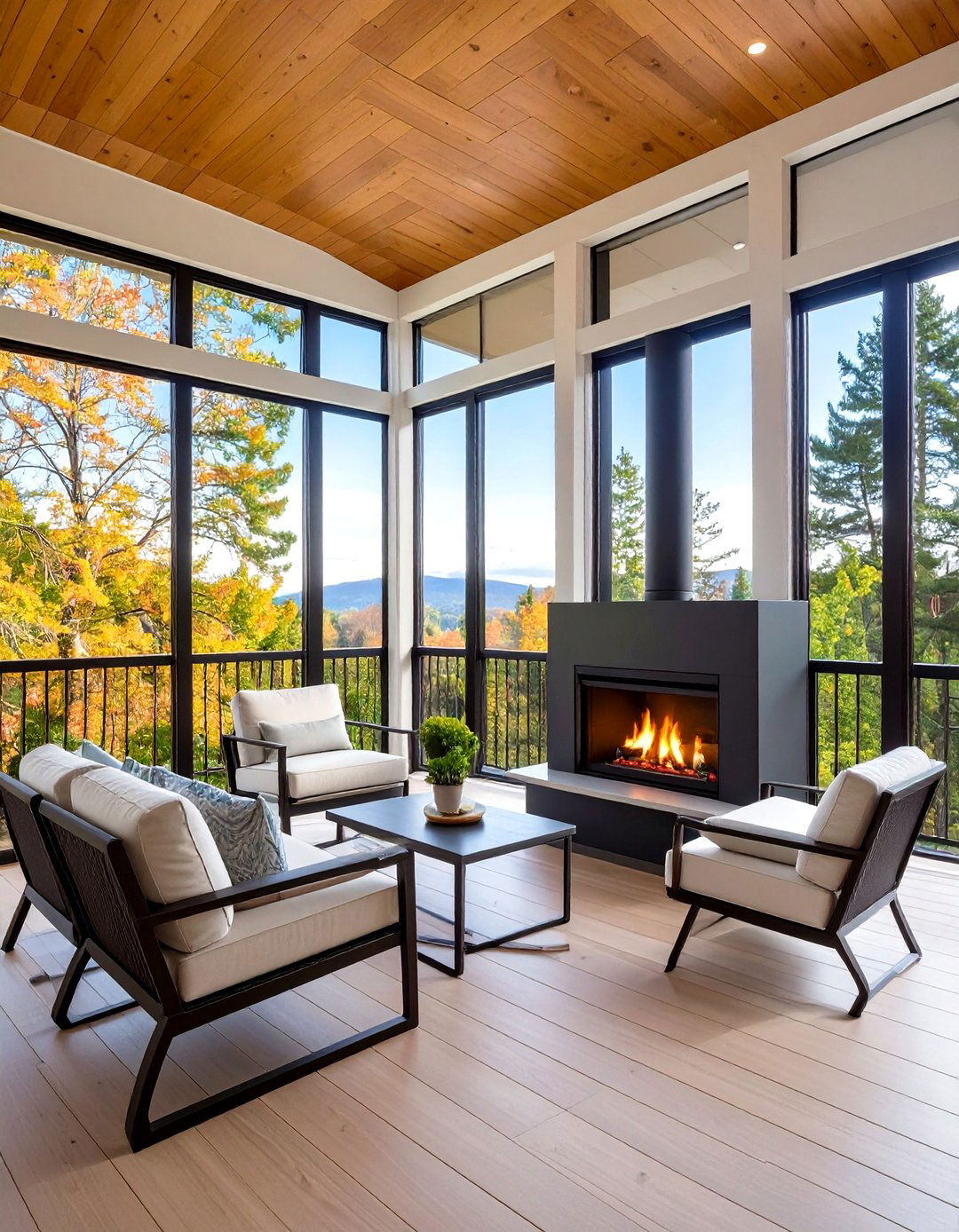
Properly designed, a screened-in porch with a fireplace can be enjoyed from early spring through late fall and beyond. Heat sources like infrared ceiling-mounted heaters complement the fireplace, ensuring uniform warmth across the space. Seasonal screens or vinyl glazing systems seal out drafts and pests while preserving views of the landscape. Incorporating insulated ceilings and heated flooring further enhances comfort in cooler conditions. Thoughtful layering—throw blankets, plush rugs, and weatherproof draperies—keeps the porch welcoming year-round.
4. Incorporating Stone and Brick Facades
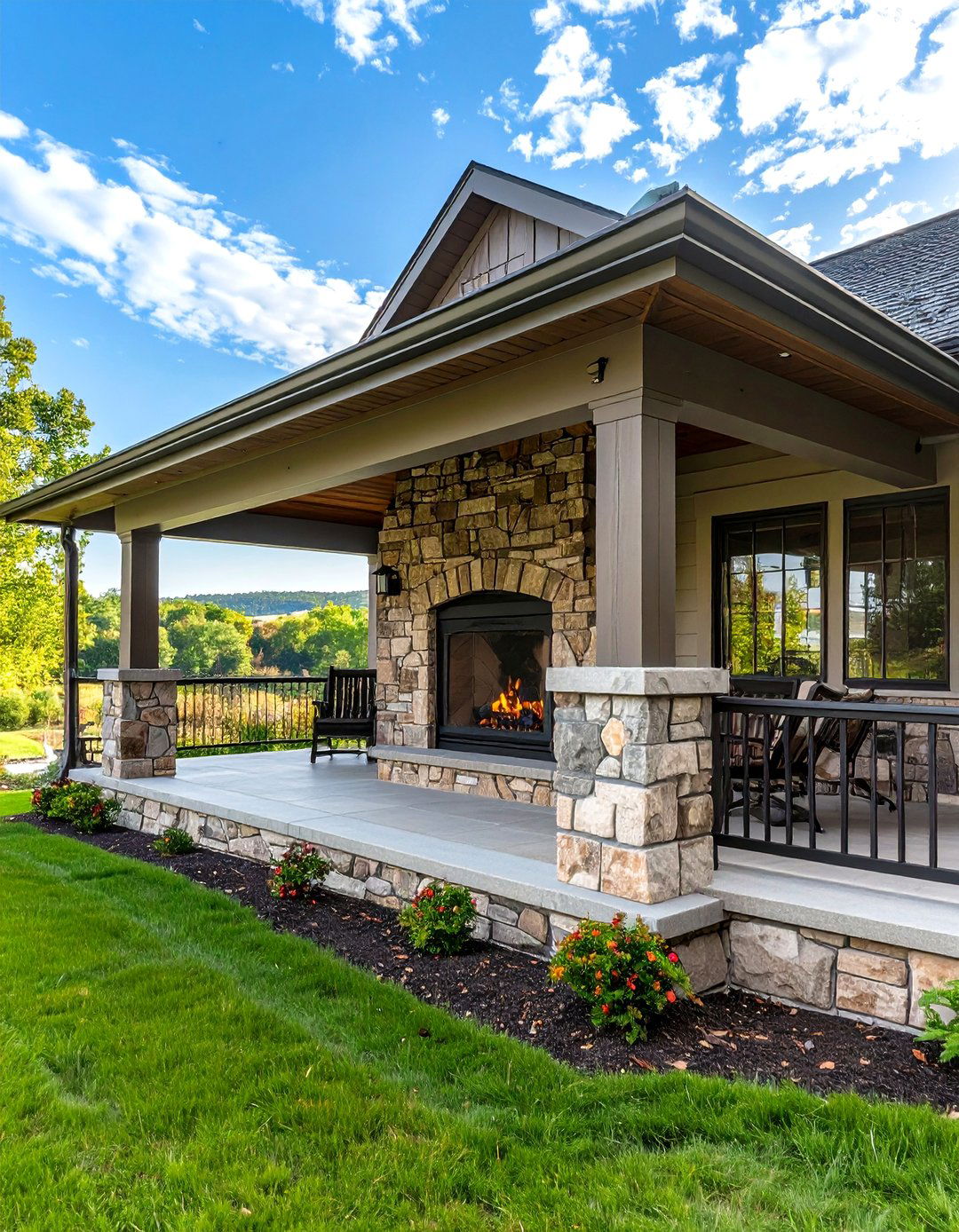
Natural stone and brick facades lend timeless elegance and durability to an outdoor fireplace. Fieldstone veneers mirror surrounding landscape hues, seamlessly integrating the hearth into a rustic setting. Brickwork in varying patterns adds texture and visual interest, from herringbone to soldier courses. Porches with neutral palettes benefit from the warmth and depth these materials provide. Ensure proper mortar selection and sealing to withstand freeze-thaw cycles and guard against moisture infiltration.
5. Rustic Charm: Using Natural Materials
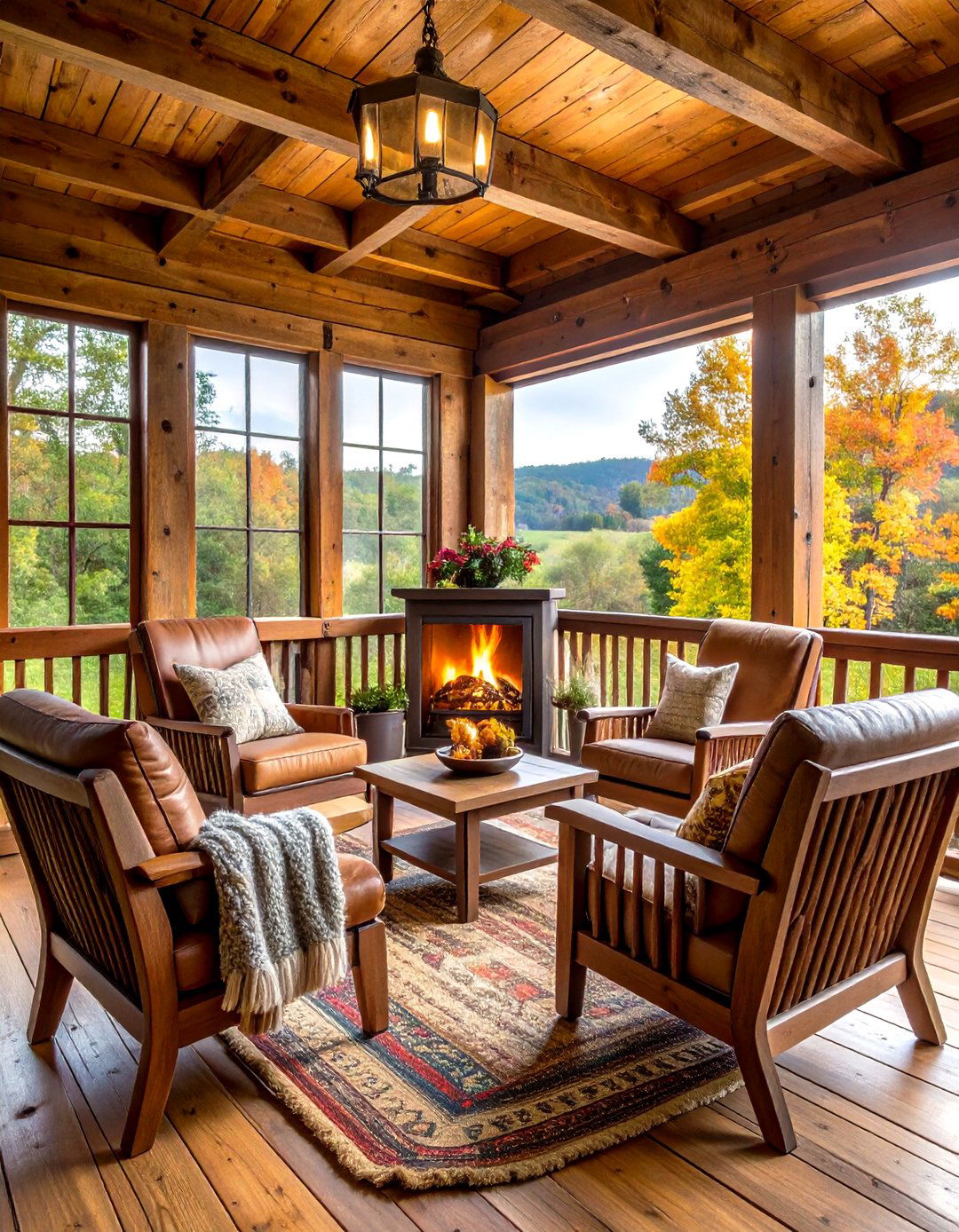
Exposed timber beams, reclaimed wood mantels, and rough-hewn stone accents infuse a porch with authentic rustic character. Salvaged barnwood mantels above the fireplace showcase history and add handcrafted warmth. Complementary decor—leather chairs, wool throws, and woven baskets—accentuate the cabin-like atmosphere. Natural finishes age gracefully, deepening in patina over time. This aesthetic celebrates imperfection and highlights material provenance, creating an inviting, homey vibe.
6. Modern Minimalist Fireplace Designs
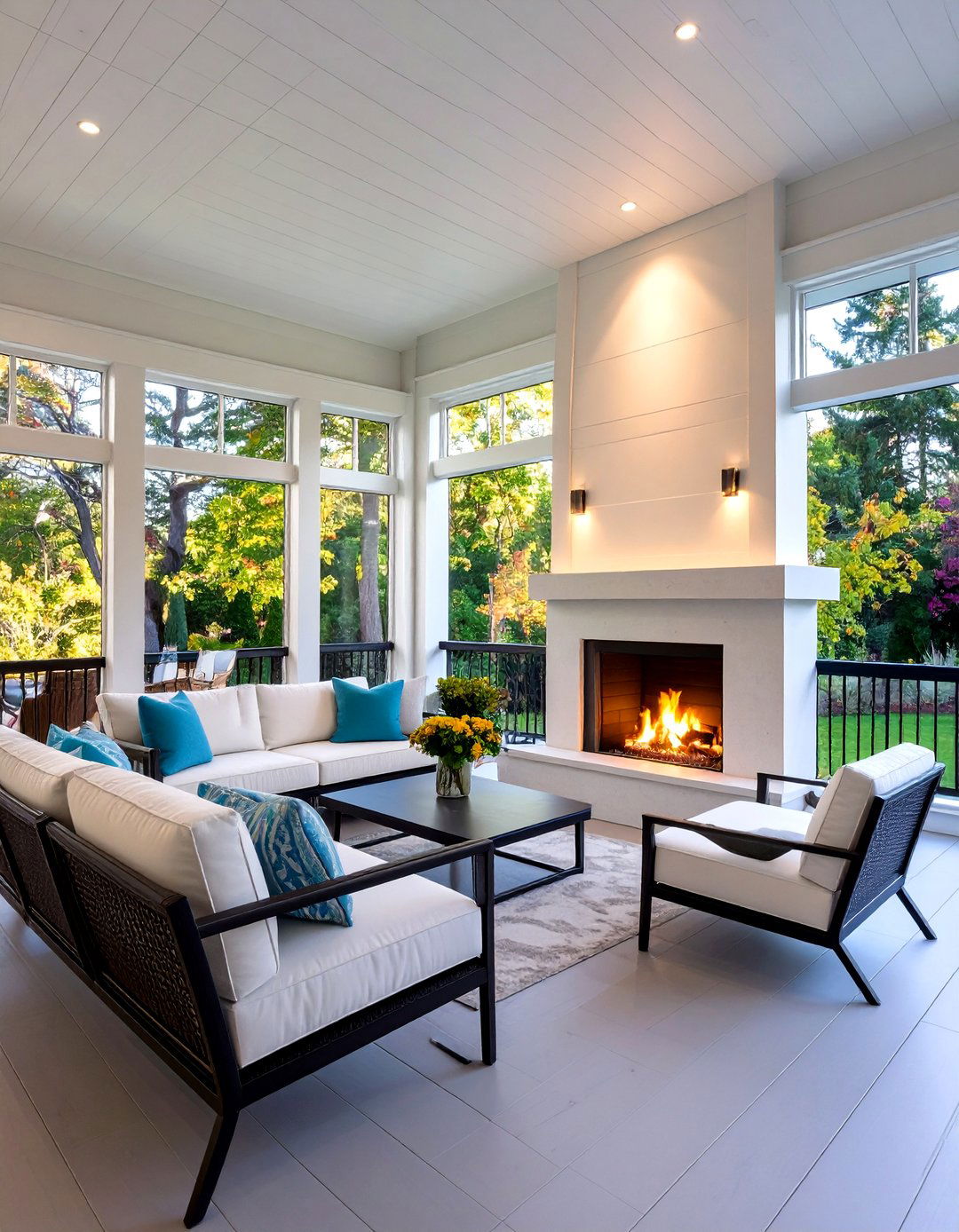
Clean lines, simple surrounds, and monochromatic palettes define modern minimalist porches. Sleek electric or linear gas inserts sit flush within drywall or plaster surrounds, eliminating visual clutter. Floating hearths crafted from polished concrete or steel maintain a streamlined appearance. Integrated storage keeps tools and logs hidden, preserving the minimalist ethos. Accent lighting—recessed LEDs or concealed strips—underscores the fireplace as an artful focal point.
7. Integrating Built-in Seating Around the Fireplace
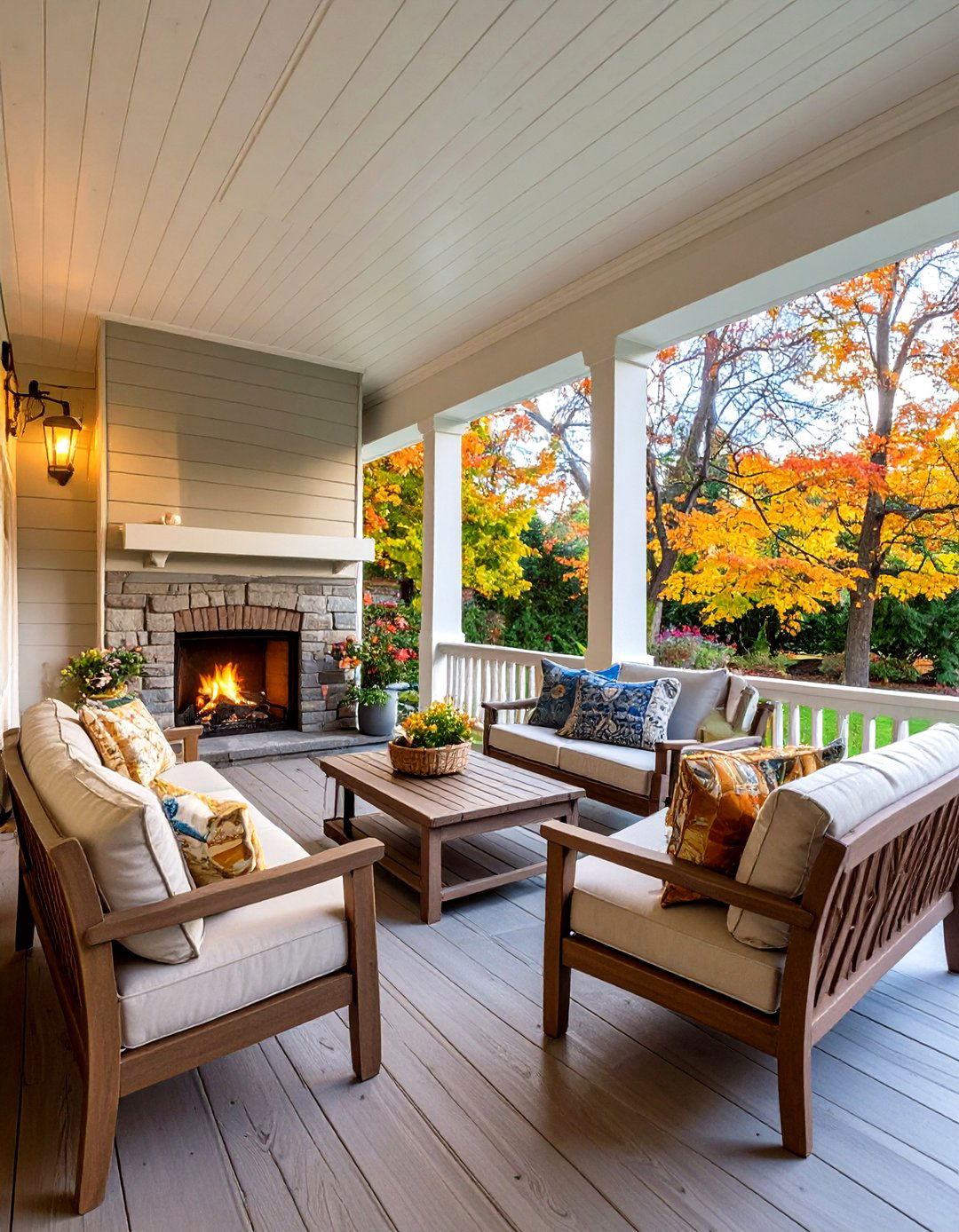
Custom-built benches flanking a fireplace optimize seating and foster social interaction. Upholstered cushions in outdoor-grade fabrics ensure durability and comfort. Storage under benches conceals blankets, pillows, and firewood. Curved layouts promote inclusive gatherings, while straight benches suit narrower porches. Coordinate wood tones and paint colors to create a cohesive look that ties together seating and hearth elements.
8. Maximizing Square Footage with Corner Fireplaces
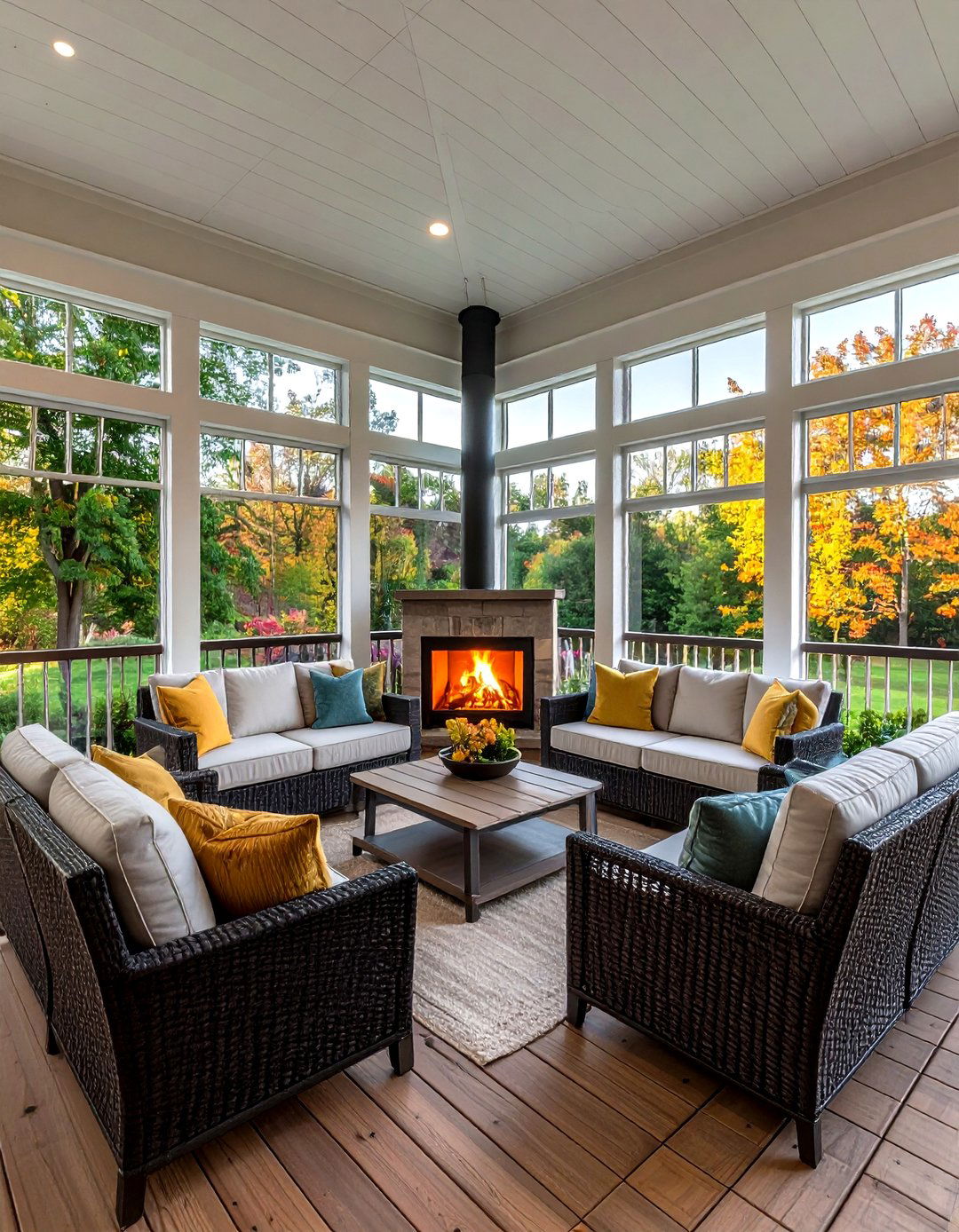
Corner fireplace installations free up central wall space, enhancing traffic flow and furniture arrangement. Prefabricated units or bespoke masonry designs fit snugly into corners, optimizing compact porches. L-shaped seating or sectional sofas naturally orient toward the hearth. Corner hearths also allow dual viewing angles, creating two separate conversational zones. This approach works particularly well in porches with asymmetrical layouts or multiple entry points.
9. Combining Fireplaces with Outdoor Kitchens

Pairing a fireplace with an outdoor kitchen creates a multifunctional entertainment hub. Position the hearth at one end of the porch and kitchen appliances at the other, defining distinct cooking and lounge areas. Durable countertops—granite, porcelain, or stainless steel—stand up to outdoor conditions. Overhead pergolas or retractable roofs shelter chefs and guests alike. Integrated bar seating near the hearth encourages pre- or post-dinner relaxation around the fire.
10. Four-Season Porches with Fireplace and Insulation
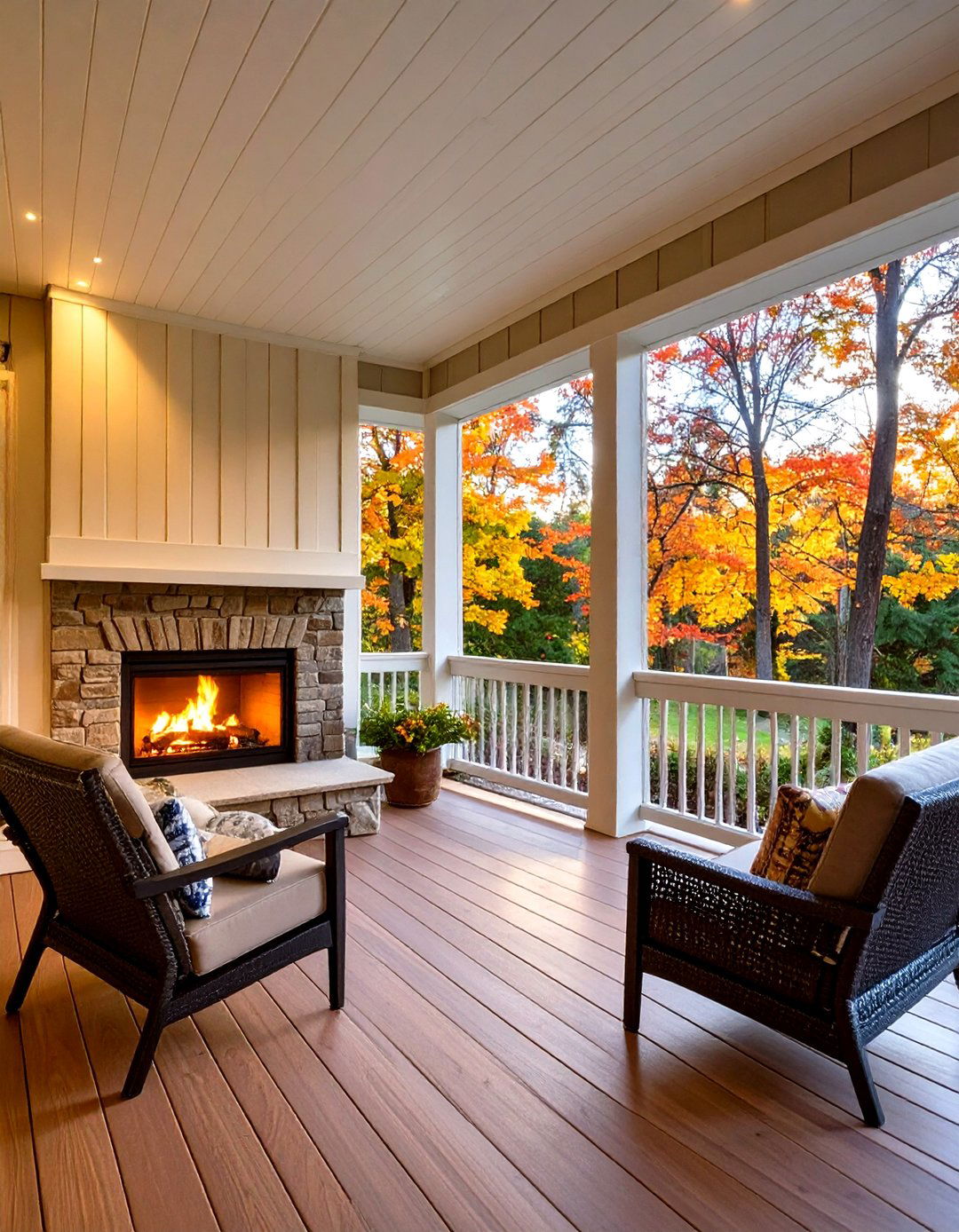
Transform your screened porch into a four-season retreat by insulating walls, ceiling, and floors. Vinyl or glass panels replace screens in winter, trapping heat from the fireplace inside. Composite decking with thermal barriers prevents cold transfer through the floor. Add radiant floor heating for consistent warmth underfoot. Insulated window units and weather-stripping around doors ensure energy efficiency and comfort.
11. Selecting Durable Flooring for Fireplace Porches
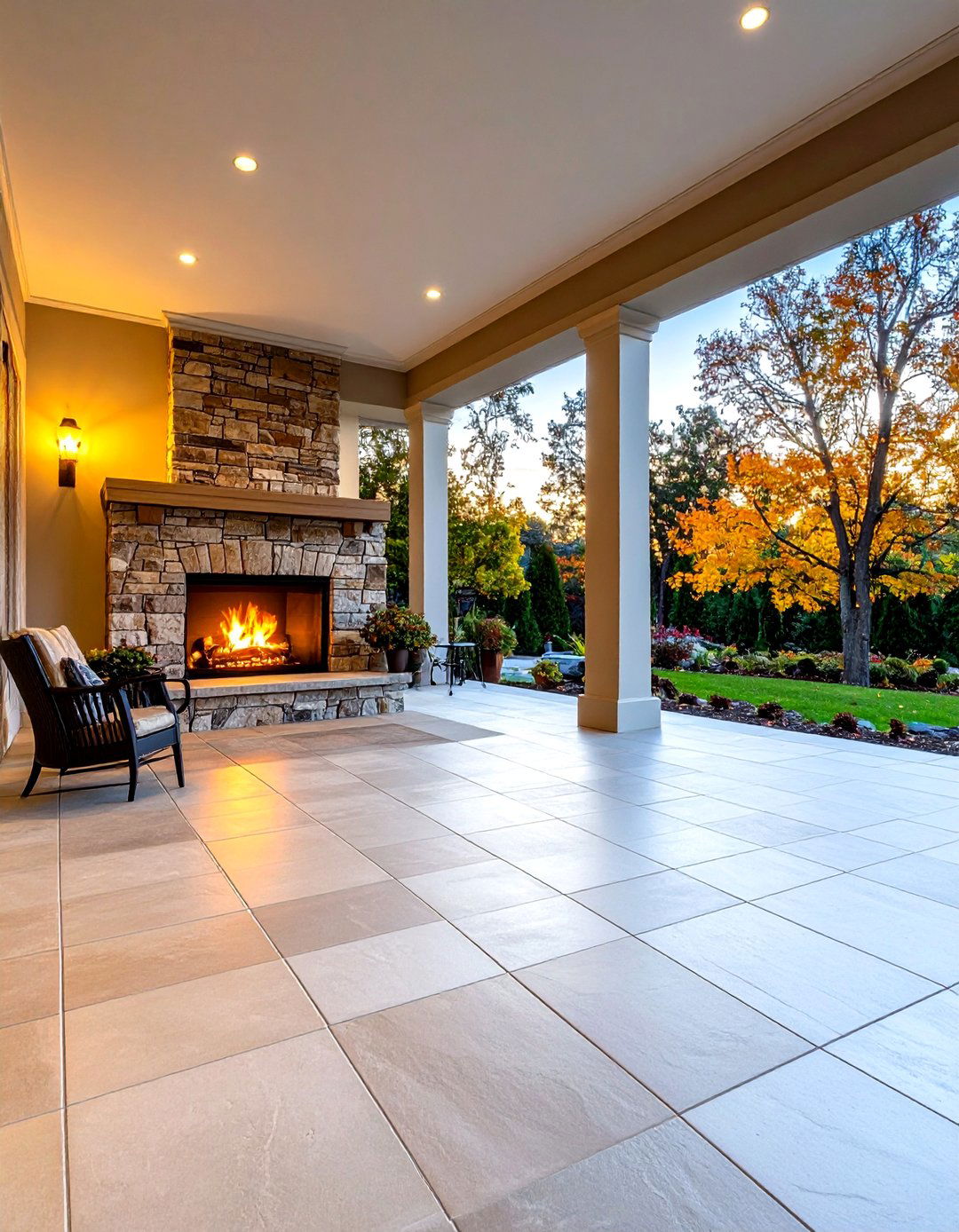
Heat-resistant materials like porcelain tile, natural stone, and sealed concrete are ideal near fireplaces. These surfaces withstand ember fall and are easy to clean. Wood-look porcelain combines warmth of wood aesthetics with low maintenance. Outdoor-rated rugs define seating areas while protecting floors. Proper underlayment and slope ensure water drainage and prevent material degradation.
12. Lighting and Ambiance: Chandeliers and Wall Sconces
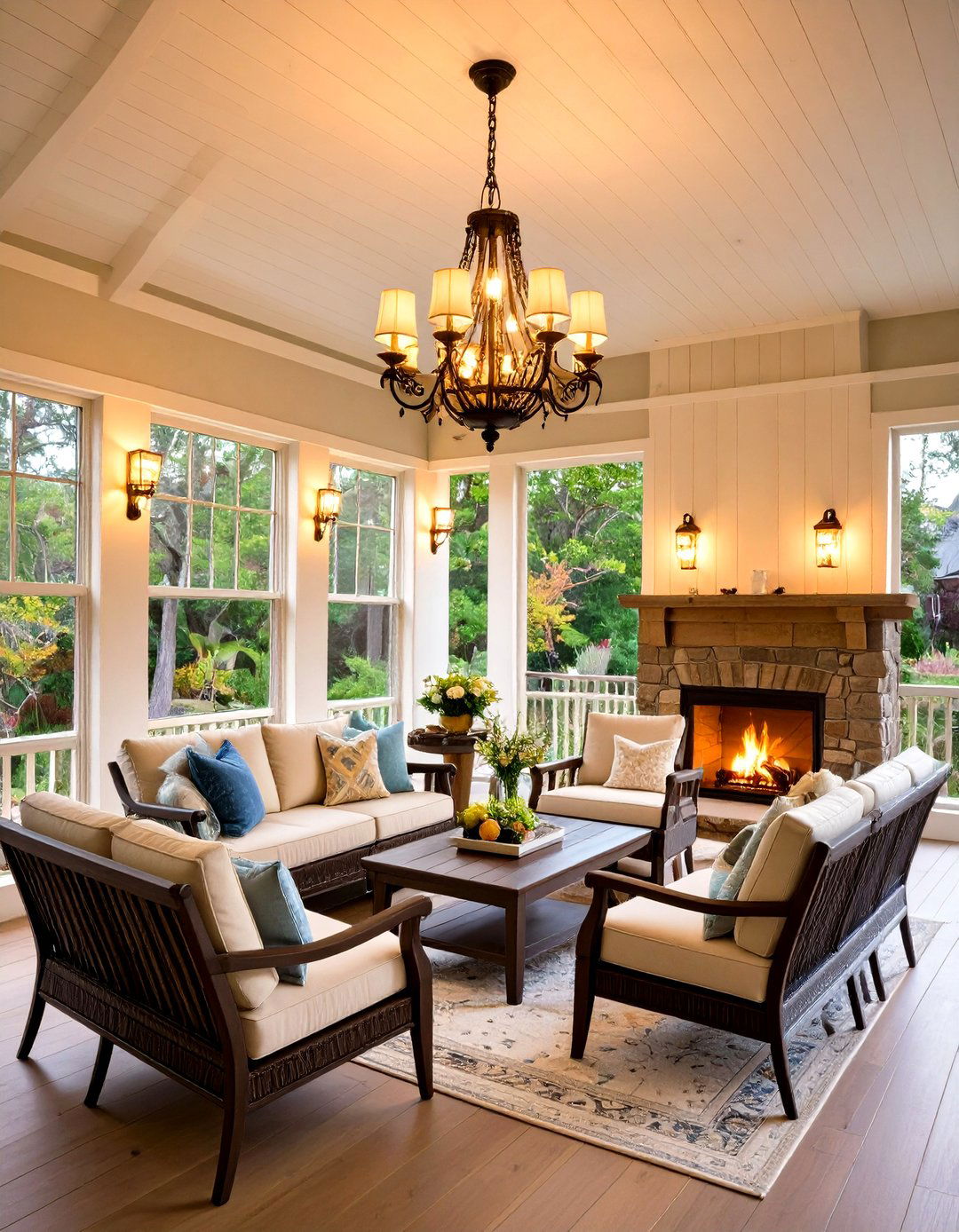
Layered lighting enhances both functionality and mood on screened porches. A central chandelier or pendant light above seating adds decorative flair, while wall sconces flanking the fireplace create soft, inviting illumination. Dimmable LED fixtures allow for customizable brightness levels. String lights or carefully placed uplighting accentuate architectural features. Integrate smart controls for seamless operation from indoors.
13. Screen Materials and Insect Protection
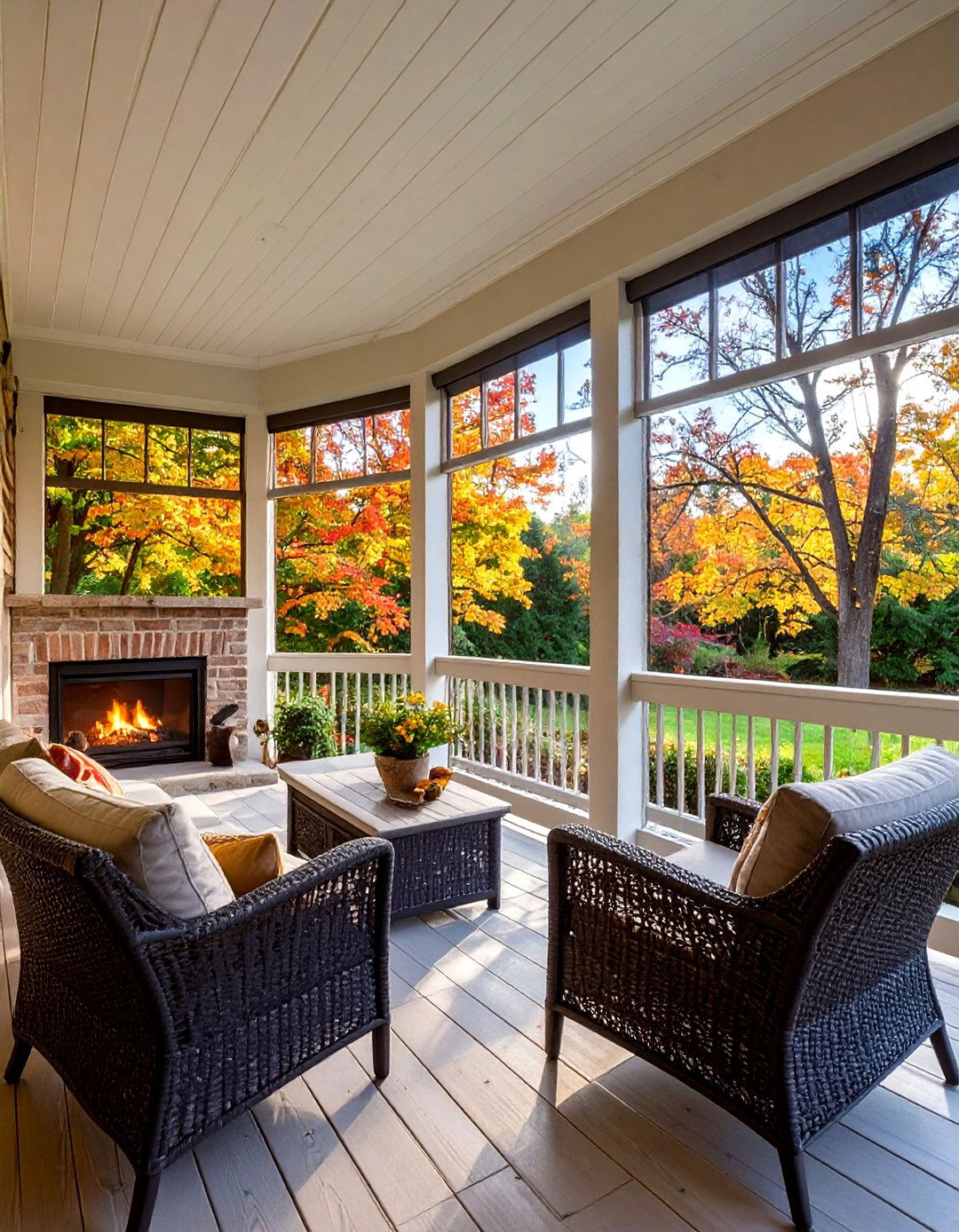
High-performance mesh screens block pests without obstructing views. Fiberglass and aluminum screens balance durability with transparency. Retractable screens offer flexibility, extending the bug barrier only when needed. For harsh climates, consider vinyl glazing panels that seal out rain and wind. Proper sealing around frames prevents insect infiltration, ensuring uninterrupted relaxation.
14. Ceiling Treatments: Beams, Fans, and Heaters

Vaulted or coffered ceilings add grandeur and openness to screened porches. Exposed wood beams create architectural interest and highlight height. Ceiling fans maintain air circulation in warm months and distribute heat from the fireplace in cooler weather. Infrared or forced-air ceiling-mounted heaters provide supplementary warmth. Choose weatherproof fixtures and ensure proper mounting clearances.
15. Furniture and Decor: Choosing Weather-Resistant Pieces
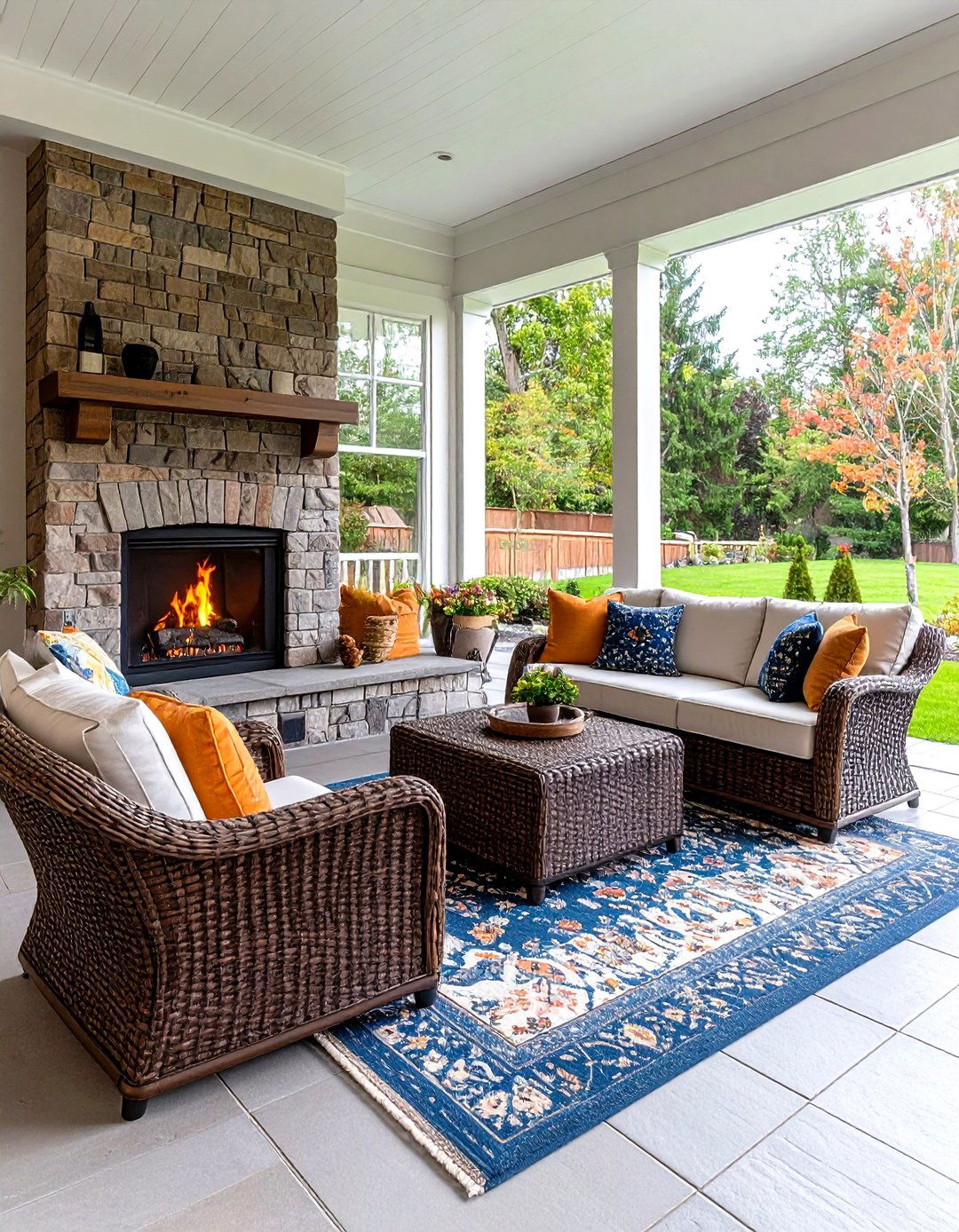
All-weather wicker, powder-coated metal, and teak furniture withstand outdoor conditions and coordinate with fireplace aesthetics. Plush cushions made from solution-dyed acrylic fabrics resist mildew, UV fading, and moisture. Outdoor rugs in polypropylene add softness and define zones. Accent tables in stone or concrete complement hearth materials. Durable decor items—lanterns, planters, and wall art—resist humidity and maintain crisp colors.
16. Safety Considerations: Ventilation and Clearance
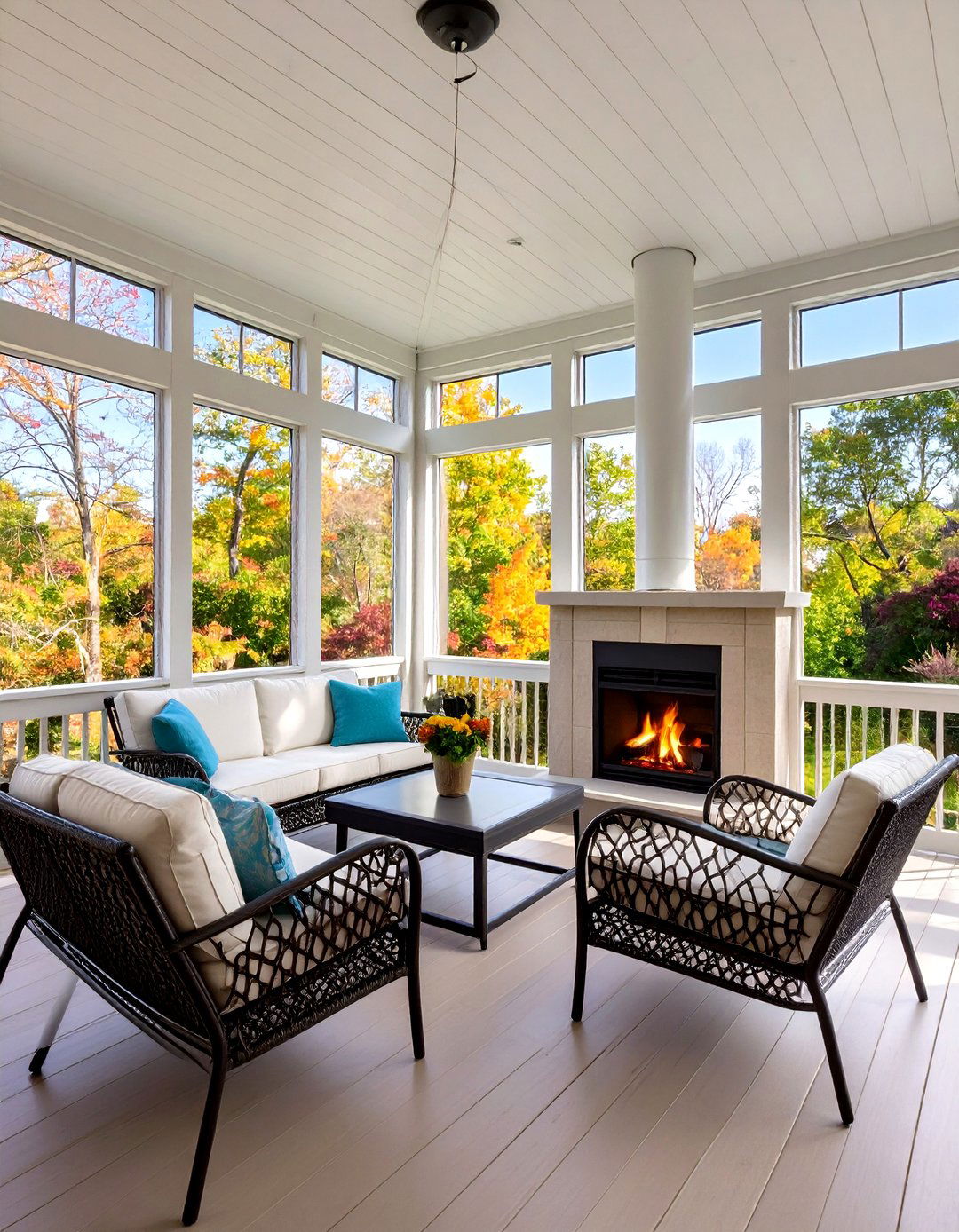
Proper ventilation is crucial to prevent smoke buildup in enclosed screened porches. Comply with manufacturer clearance recommendations between the firebox and combustible materials. Install spark arrestors or glass doors to contain embers. Include fire extinguishers and smoke detectors nearby. Engage qualified professionals to assess structural integrity and ensure adherence to local building codes.
17. Budget-Friendly Fireplace DIY Projects
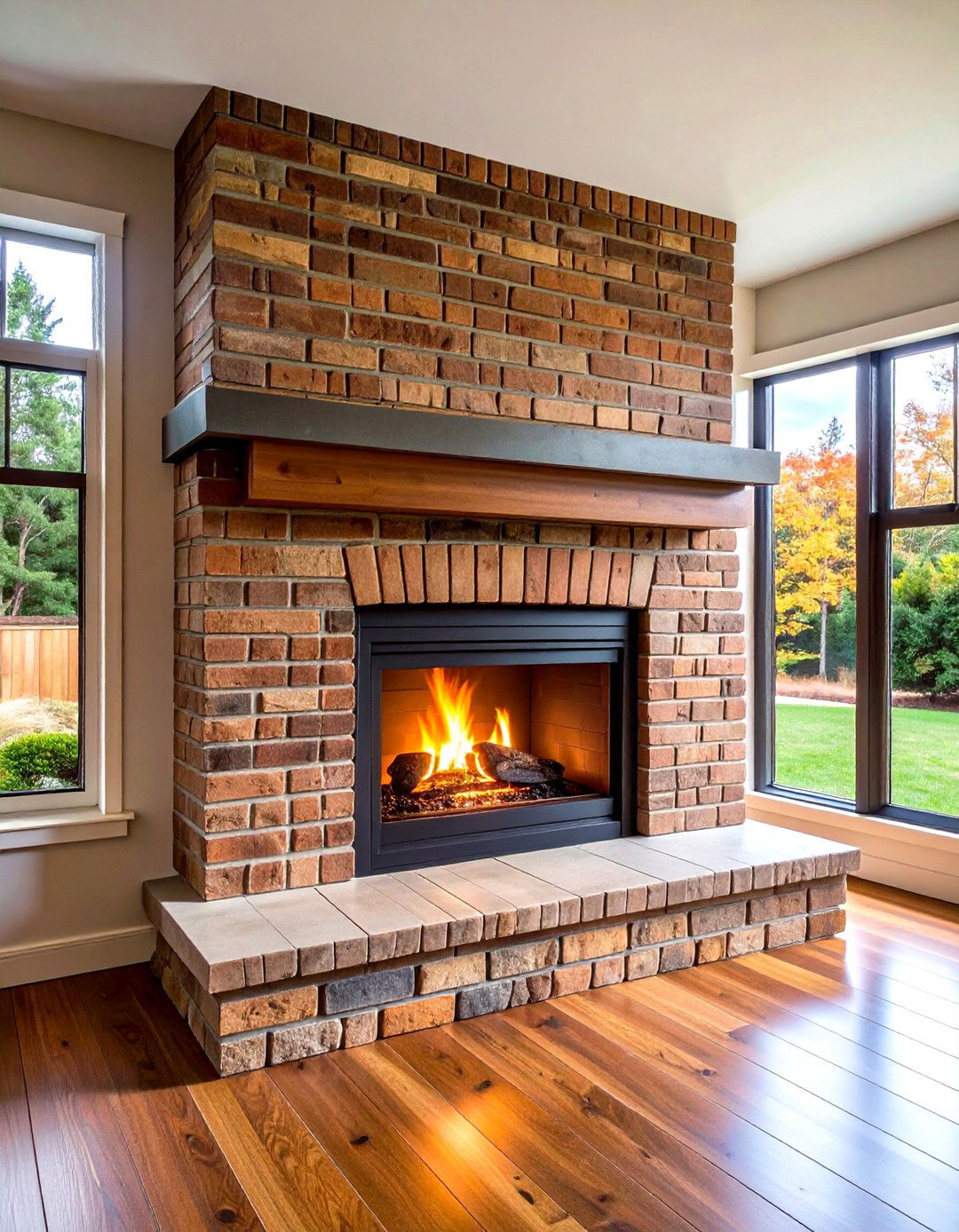
Prefab fireplace kits offer an affordable route to a cozy hearth, often including firebox, surround, and chimney components. Veneer stone or stacked brick panels can be installed with basic masonry skills. Upcycling old wood pallets into a mantel introduces character at minimal cost. Incorporate solar-powered LED logs beneath an electric insert for ambiance on a shoestring budget. Always prioritize safety and consult local authorities regarding permits.
18. Professional Installation and Permitting
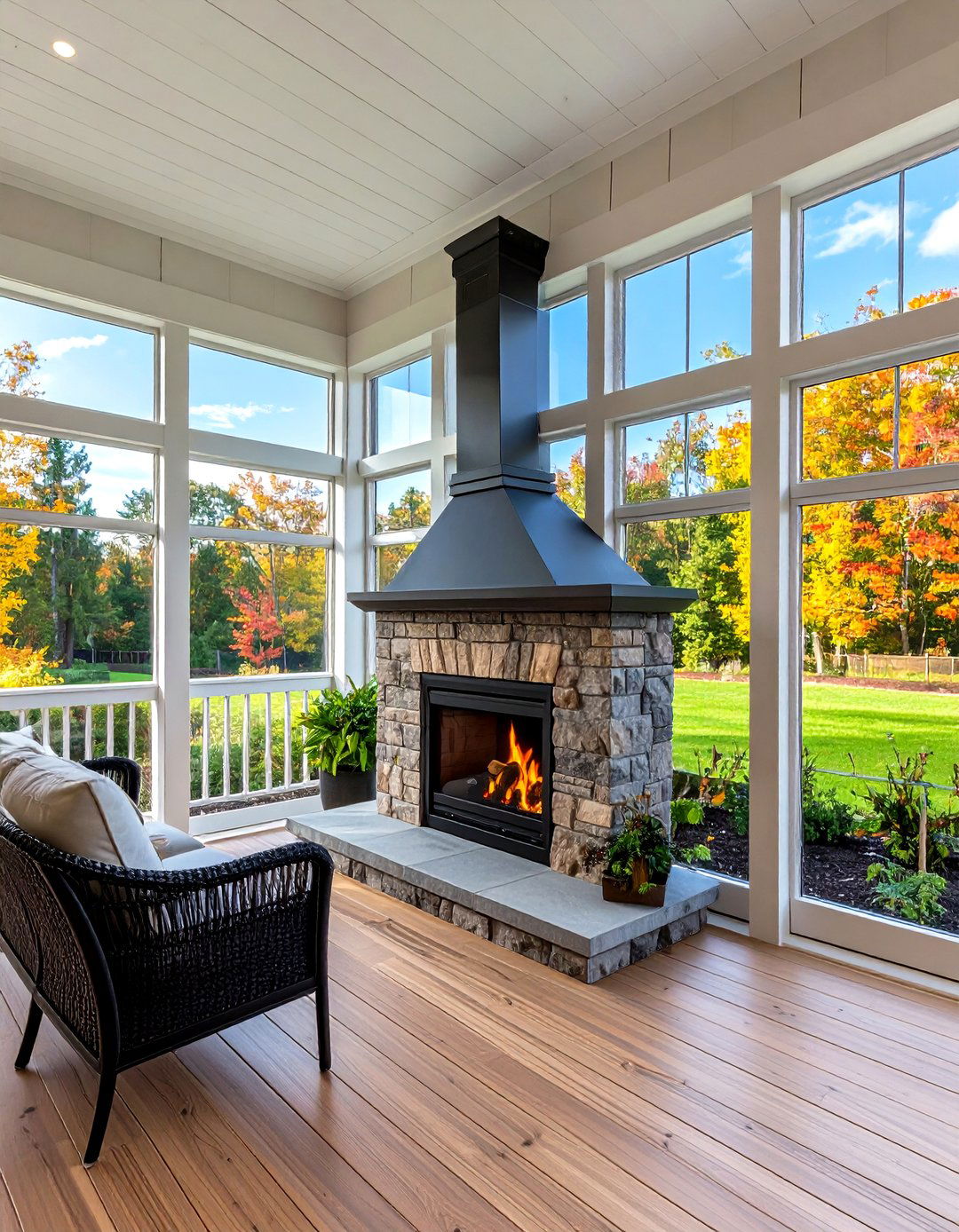
Hiring licensed contractors ensures proper fireplace installation, venting, and compliance with building codes. Permits for structural changes, gas lines, or electrical work are typically required. Professionals can advise on optimal firebox placement, hearth dimensions, and mantel specifications. Inspections by municipal authorities verify safety and quality. Investing in expert installation protects your porch system and provides peace of mind.
19. Seasonal Maintenance and Cleaning Tips
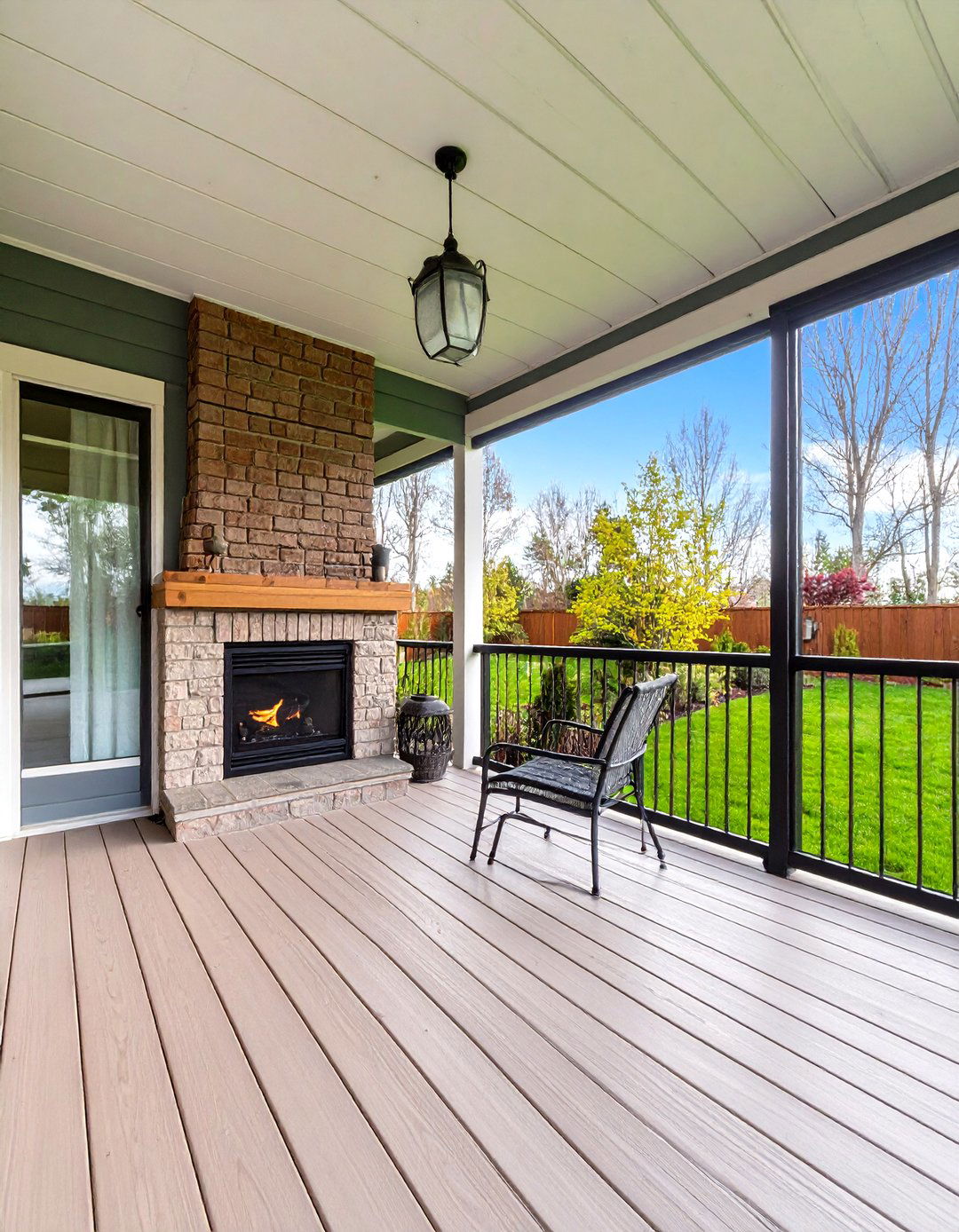
Regular chimney sweeping or vent cleaning prevents creosote buildup and ensures efficient airflow. Inspect hearth materials for cracks or mortar deterioration each spring. Clean surrounding screens and flooring of ash and debris to maintain appearance. Apply water-repellent sealers to stone and brick to guard against moisture damage. Store removable screens and cushions indoors during winter to prolong lifespan.
20. Personalizing the Space: Accessories and Color Schemes
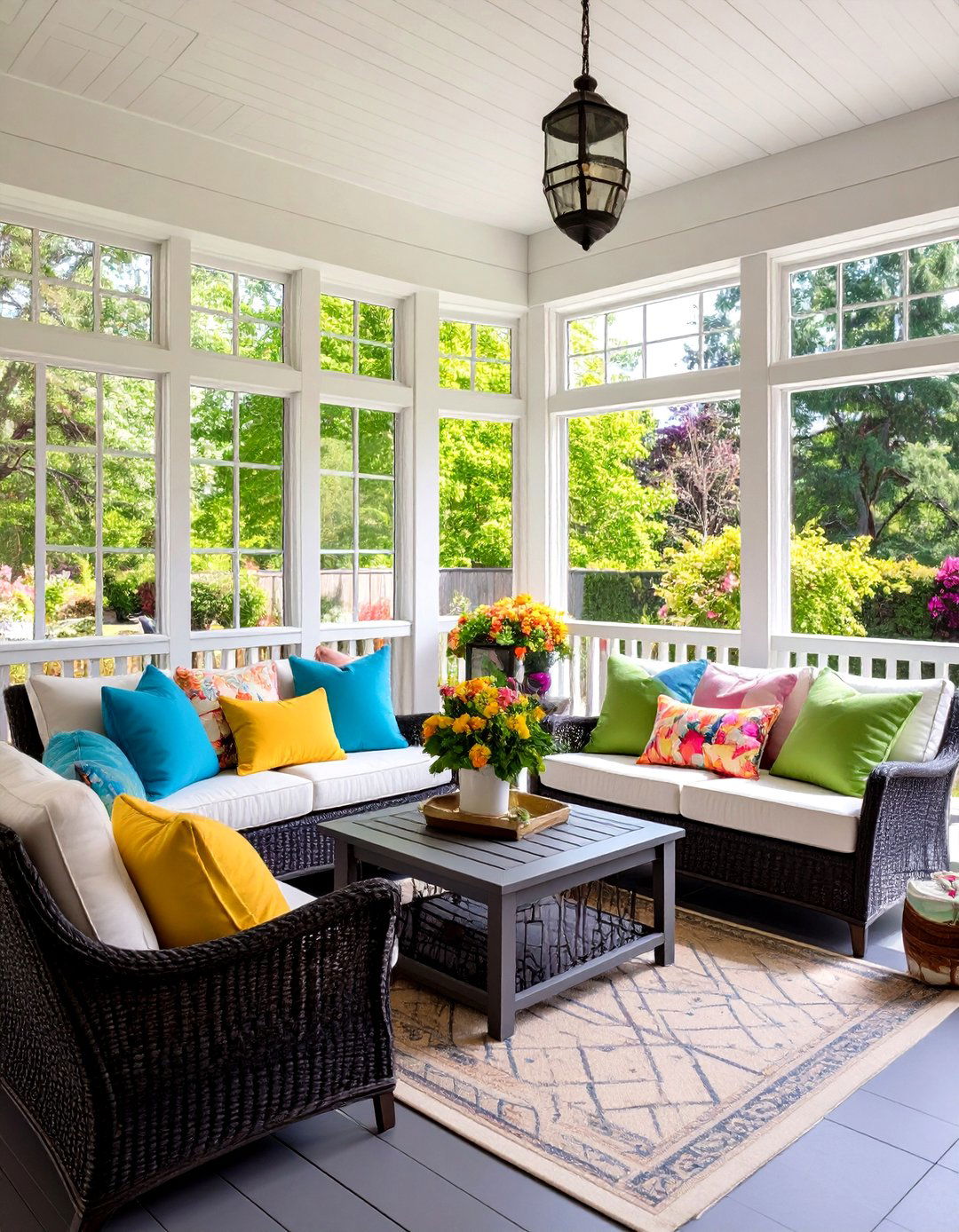
Layer textiles—throw pillows, blankets, and poufs—in complementary hues to reflect your style. Natural palettes of greens and earth tones blend with outdoor scenery, while bold accent colors add energy. Incorporate greenery through potted plants or hanging baskets for freshness. Decorative screens or art pieces on porch walls tie the design together. Choose accessories that withstand humidity and are easy to swap seasonally.
Conclusion:
A screened-in porch with a fireplace marries the best of indoor comfort and outdoor charm, creating a versatile space for relaxation and socializing. By carefully selecting the fireplace type, materials, and design elements, you can tailor the porch to your climate, aesthetic preferences, and budget. Incorporating safety considerations, professional installation, and proper maintenance ensures longevity and enjoyment for years to come. Whether you favor rustic stone facades or modern minimalism, thoughtful planning and personalized accents will make your porch fireplace the heart of your home’s outdoor living experience.


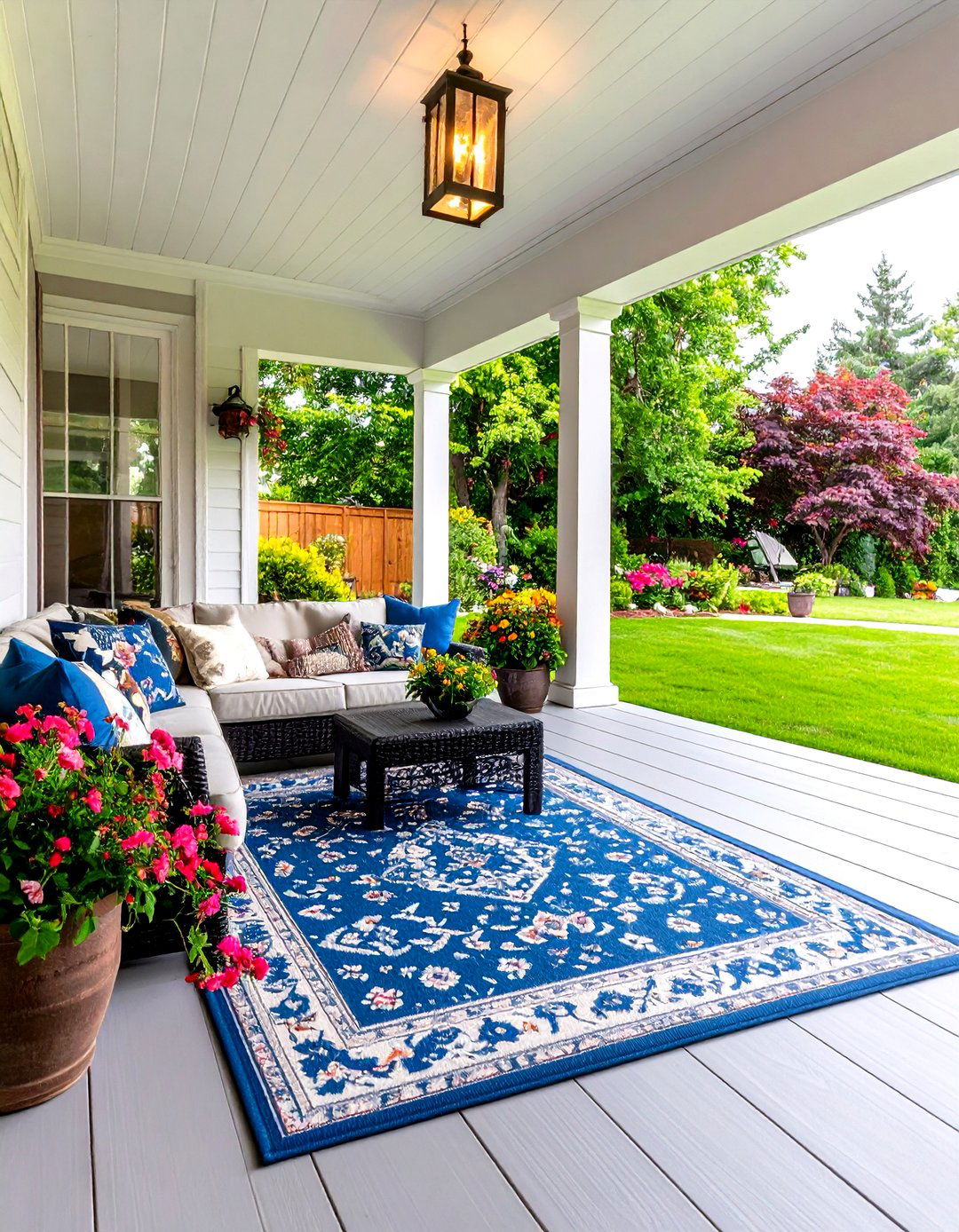

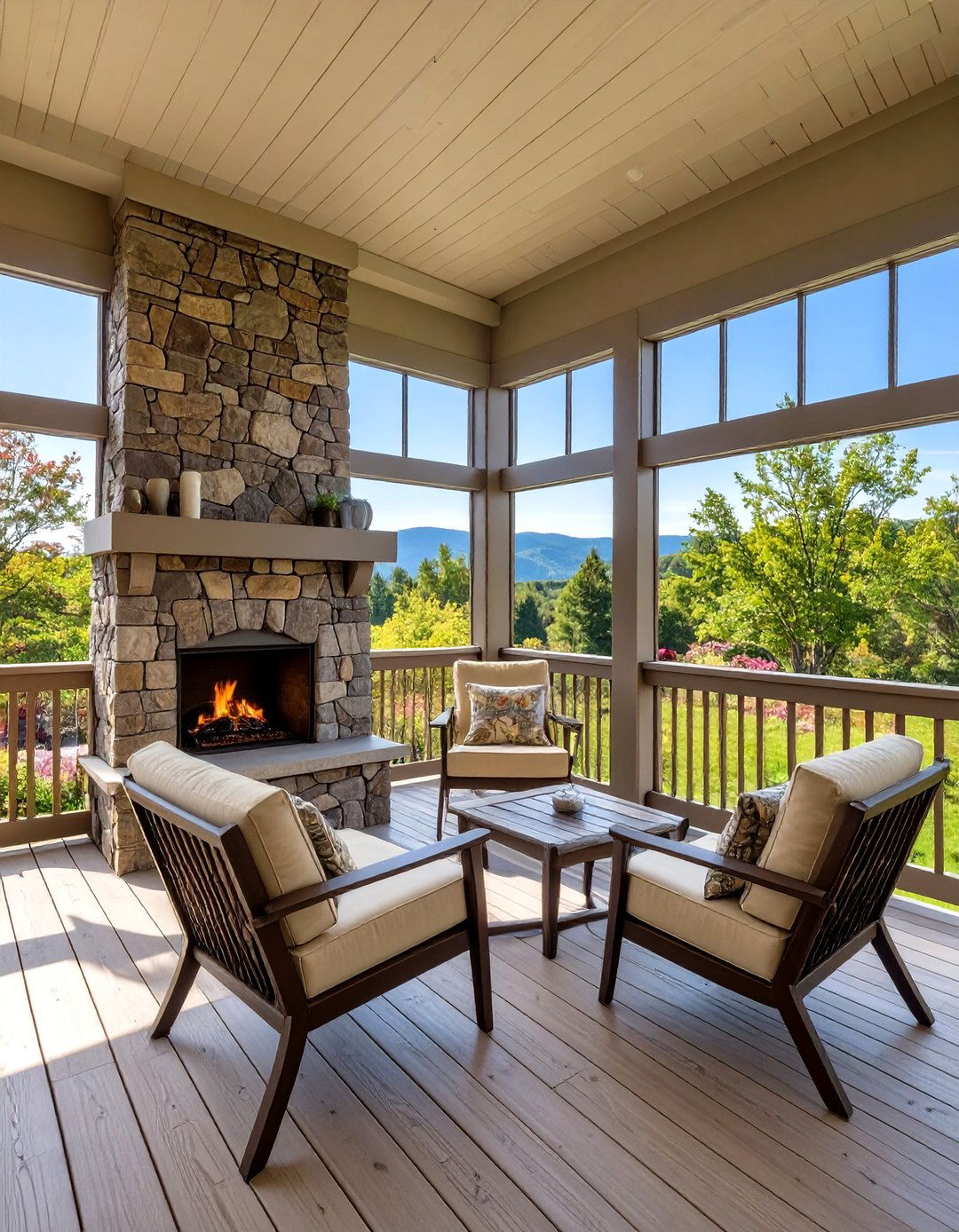


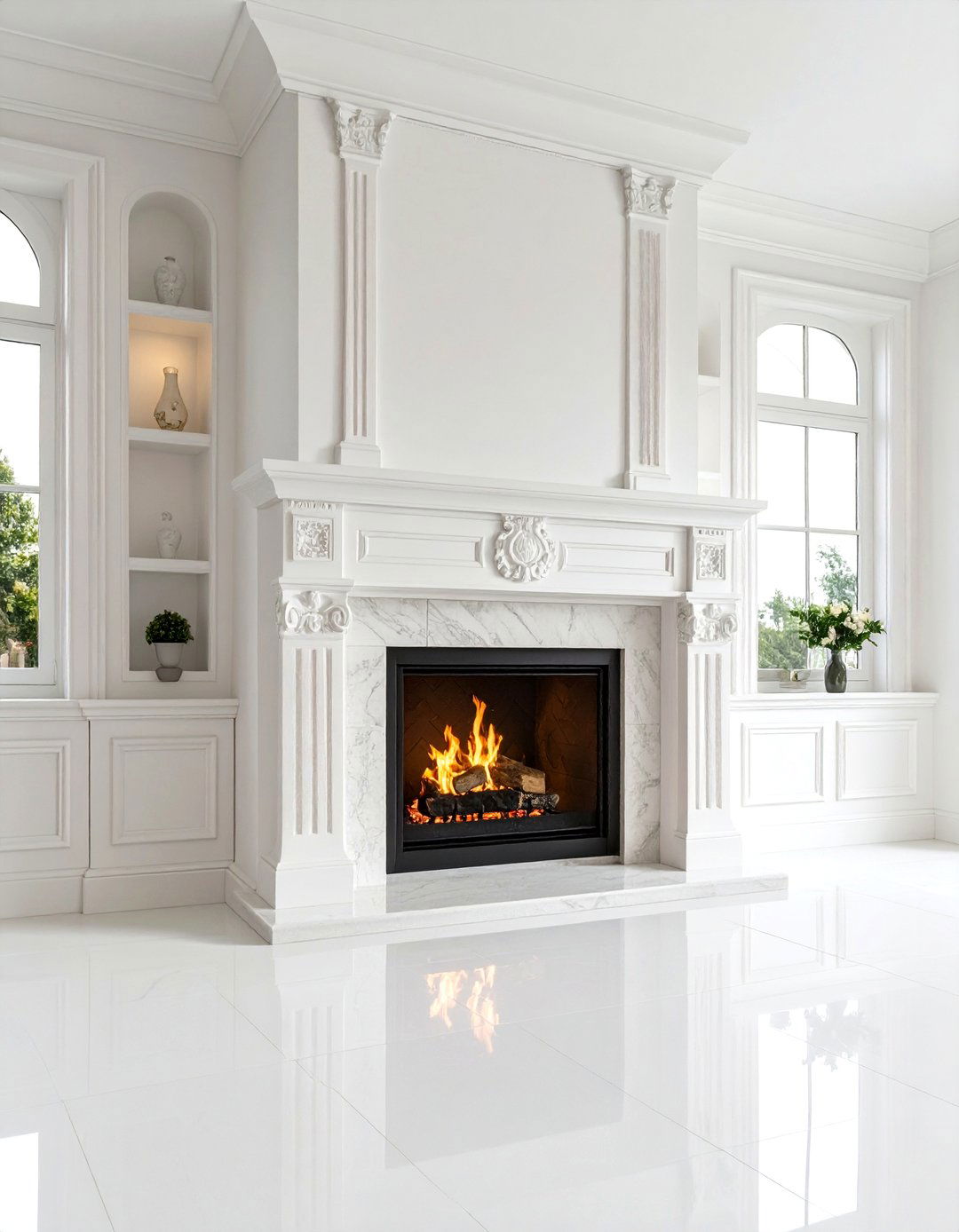
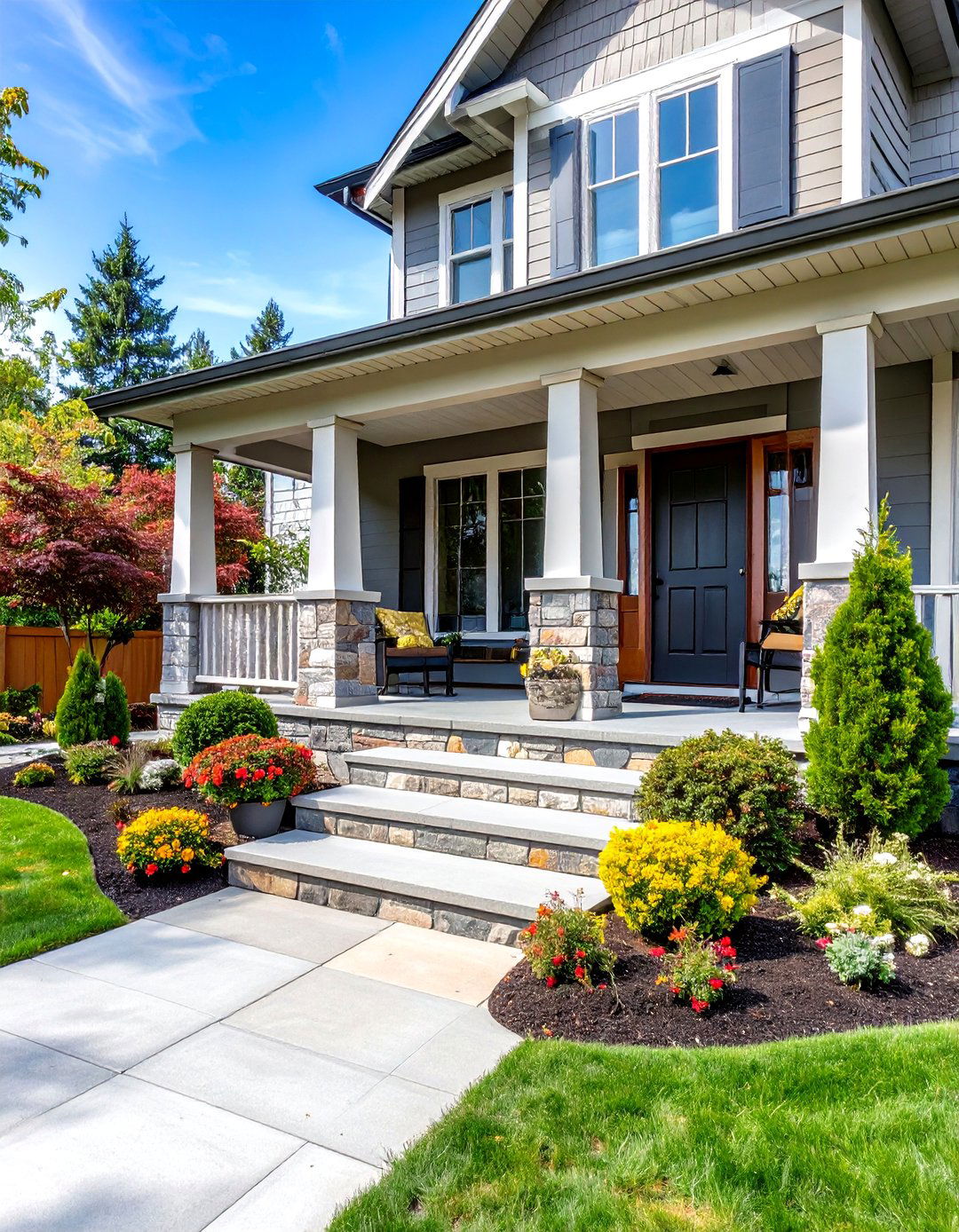
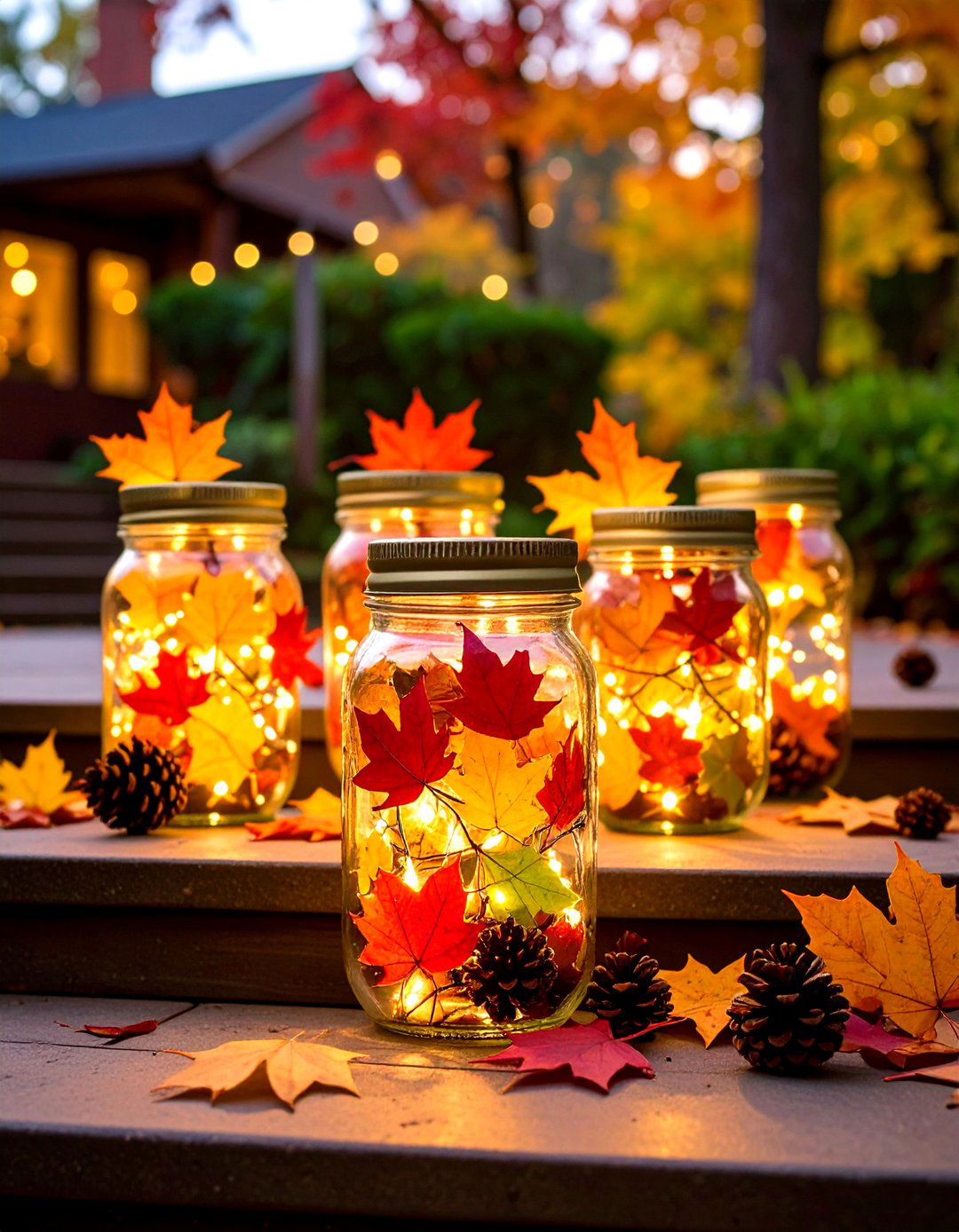

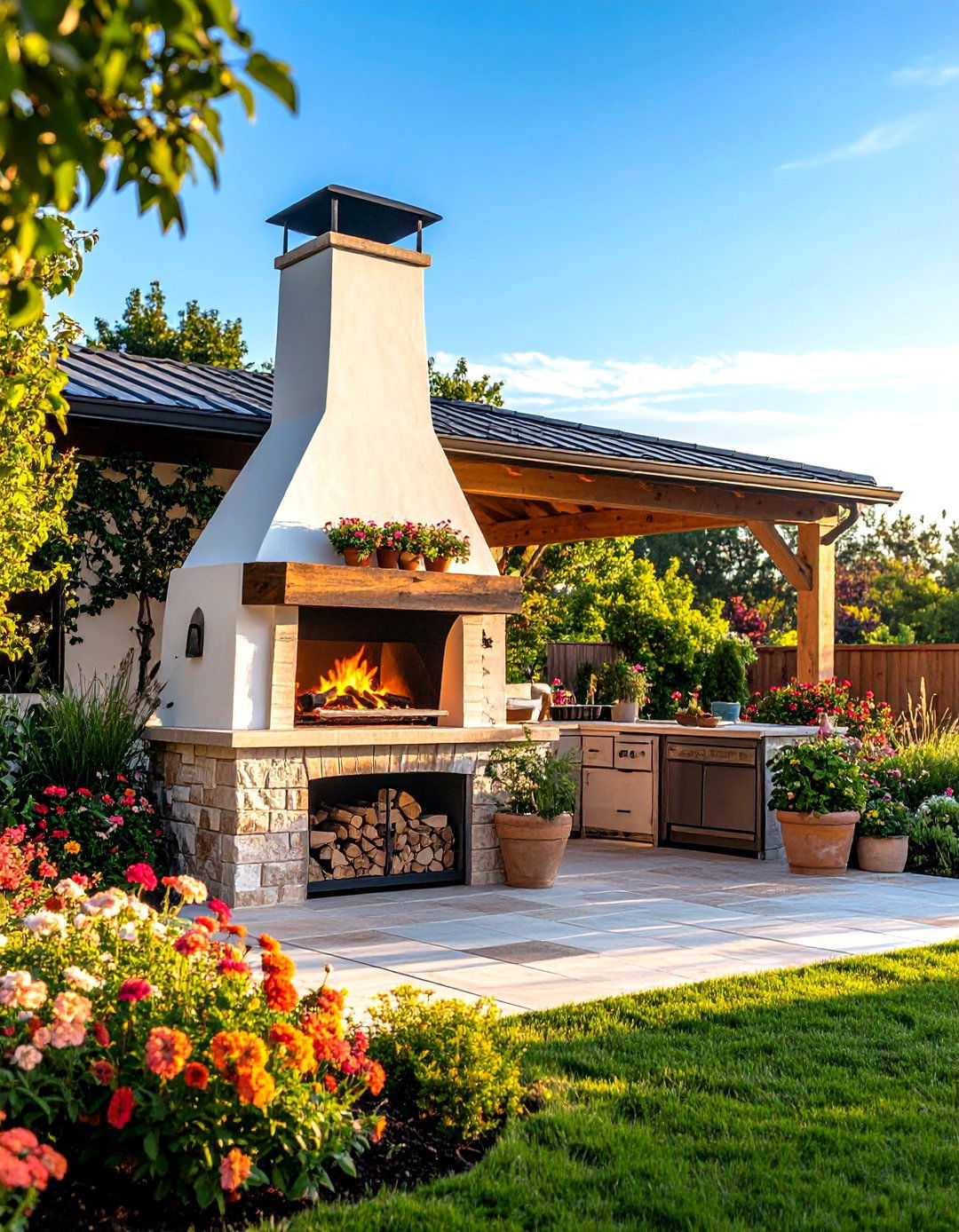

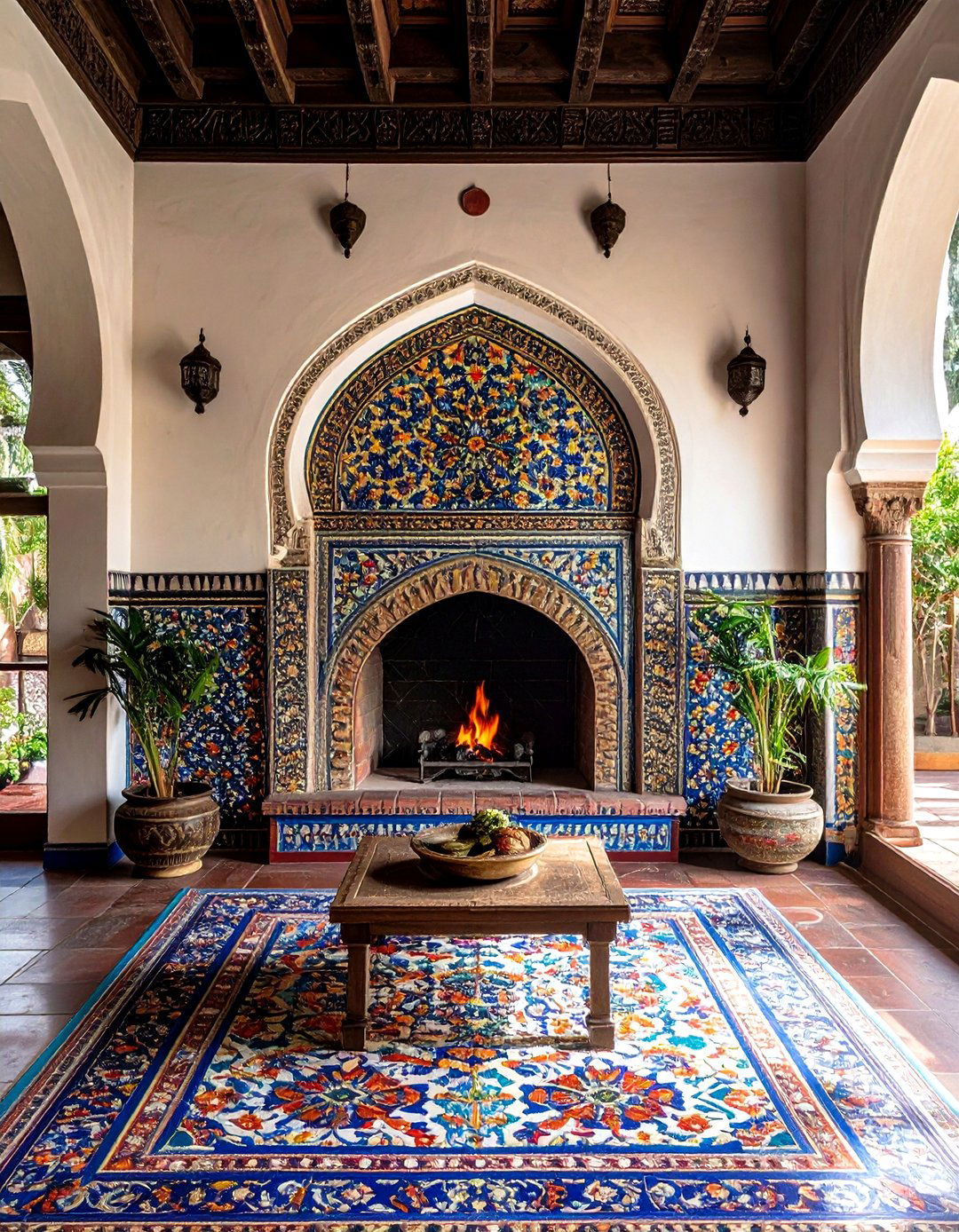
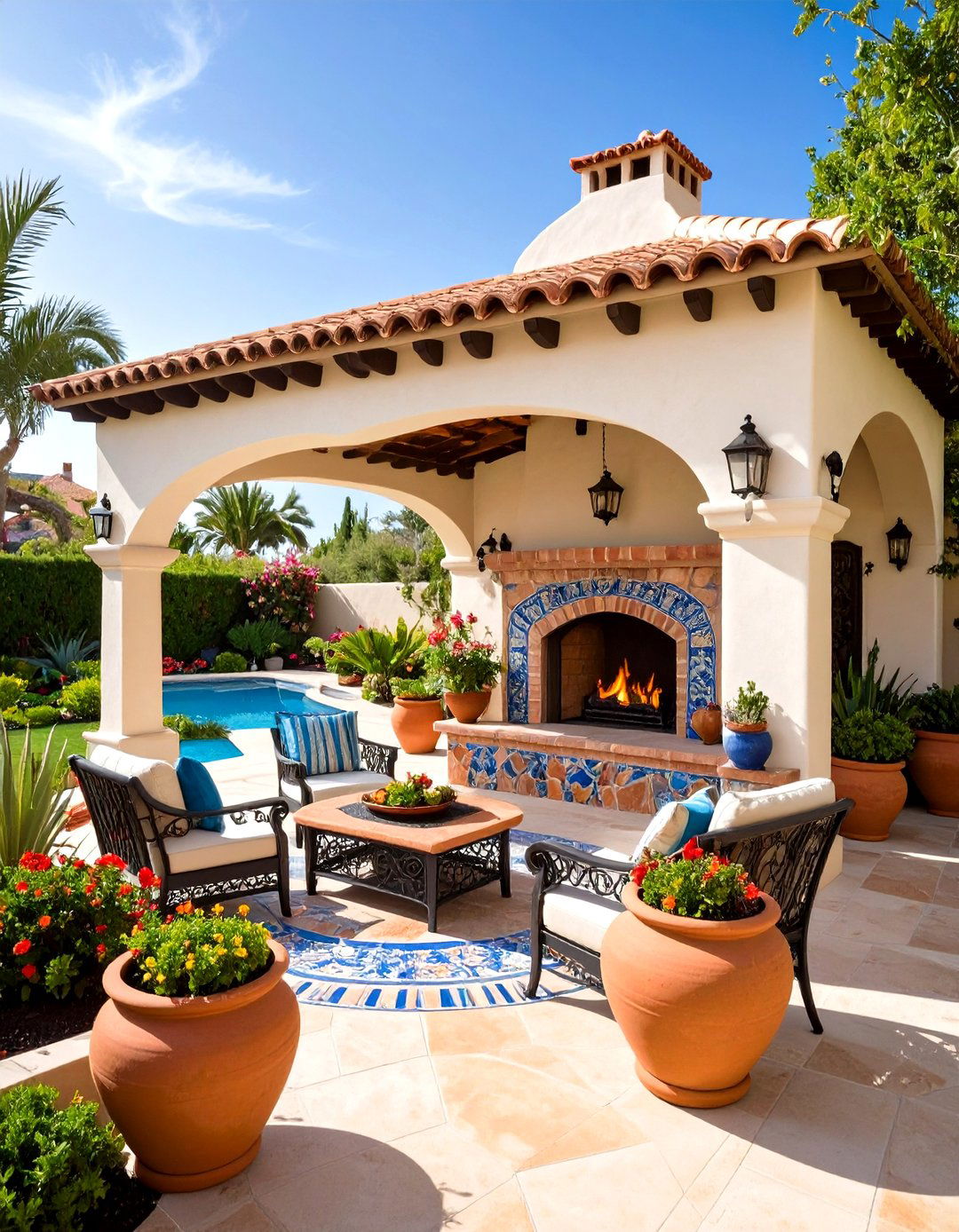
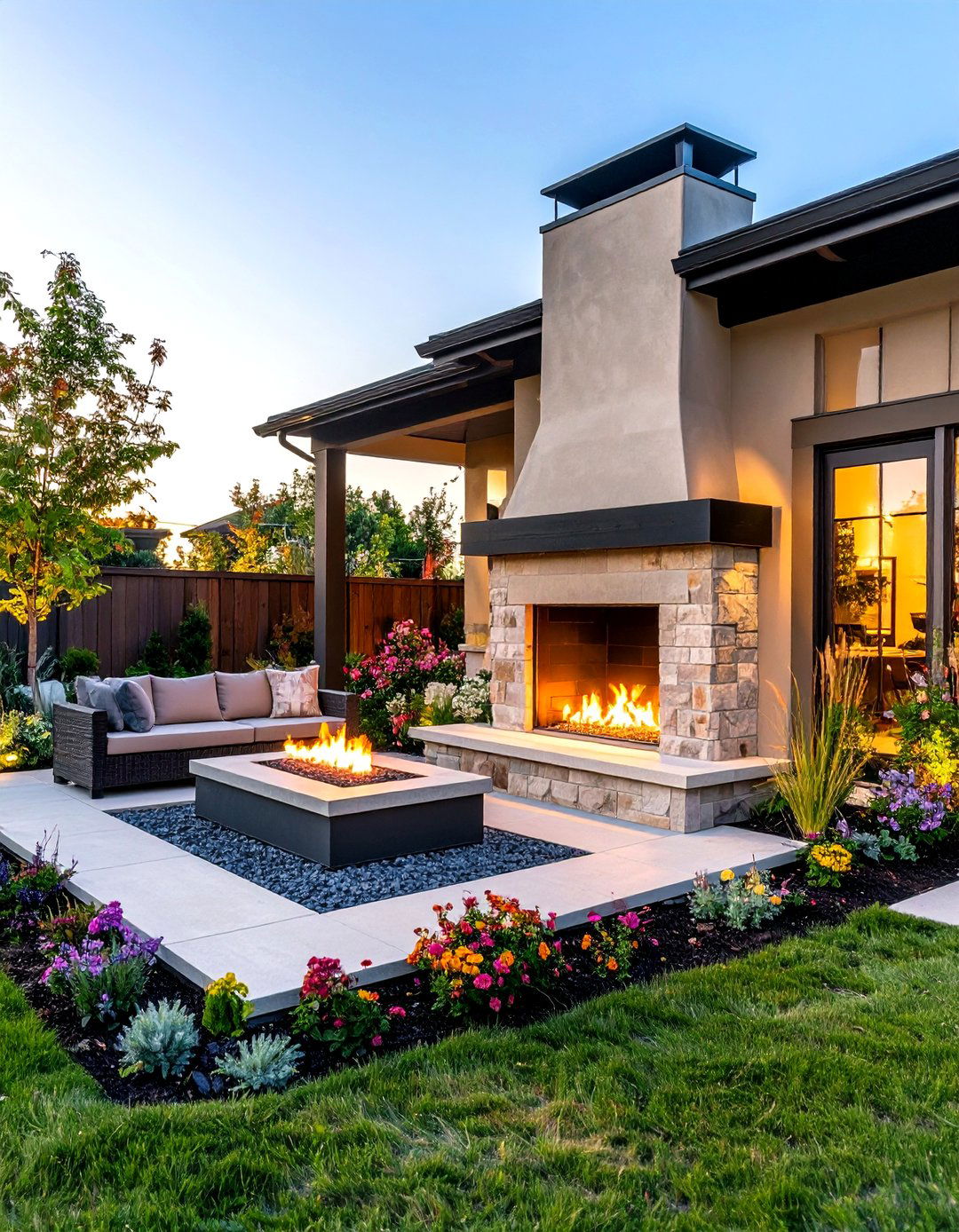
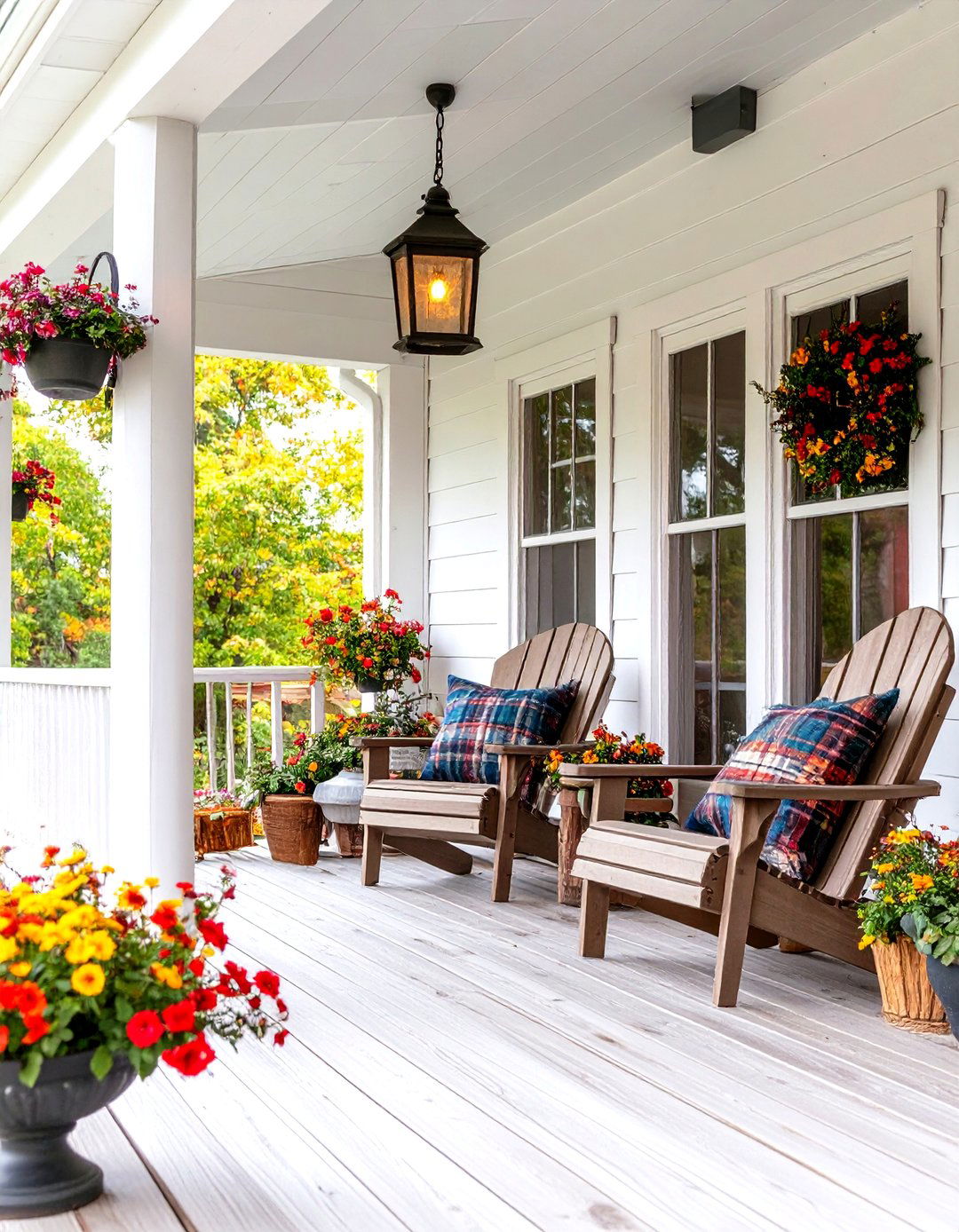
Leave a Reply